Health and Safety in Health and Social Care: A Comprehensive Analysis
VerifiedAdded on 2024/06/07
|24
|5523
|489
AI Summary
This comprehensive analysis delves into the critical aspects of health and safety within the health and social care sector. Using the case study of Fleetwood Hall Home, the paper examines legislative requirements, risk assessment, care planning, and the impact of healthcare practices on individuals. It also explores the dilemmas encountered in implementing health and safety systems and policies, the effects of non-compliance, and the importance of promoting a positive healthy and safe culture. This study provides valuable insights for healthcare professionals, managers, and policymakers seeking to enhance safety and well-being within the sector.
Contribute Materials
Your contribution can guide someone’s learning journey. Share your
documents today.
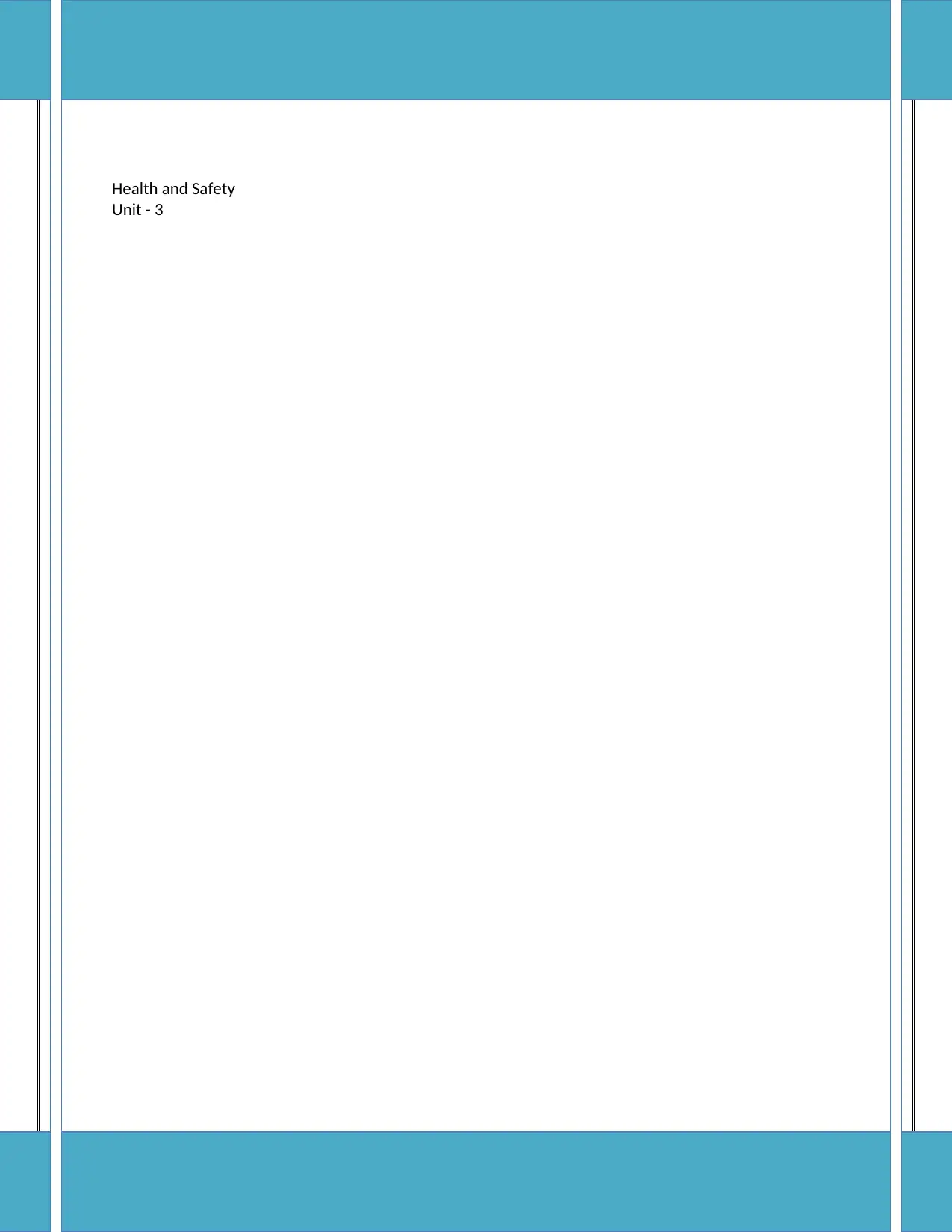
Health and Safety
Unit - 3
Unit - 3
Secure Best Marks with AI Grader
Need help grading? Try our AI Grader for instant feedback on your assignments.

Table of Contents
Introduction.....................................................................................................................................3
Task 1...............................................................................................................................................4
1.1 - Reviewing systems, policies and procedures for communicating information on health
and safety in the health and social care workplace in accordance with legislative
requirements...............................................................................................................................4
1.2 - Assessing the responsibilities in a specific health and social care workplace for the
management of health and safety in relation to organizational structures...............................6
1.3 – Analyzing the health and safety priorities appropriate for a specific health and social
care workplace.............................................................................................................................8
Task 2...............................................................................................................................................9
2.1 - Information from risk assessment informs care planning for individuals and organization
decision making about policies and procedures.........................................................................9
2.2: Impact of healthcare practices on the individual...............................................................11
2.3: Addressing of the dilemma encountered in relation to implementing systems and policies
for health, safety and security...................................................................................................13
2.4: Effects of non-compliance with health and safety legislation.............................................0
Task 3...............................................................................................................................................2
3.1 – Explaining how health and safety policies and practices are monitored and reviewed....2
3.2 - Analyzing the effectiveness of health and safety policies and practices in the workplace
in promoting a positive healthy and safe culture........................................................................4
3.3 – Evaluating own contribution to placing the health and safety needs of individuals at the
centre of practice.........................................................................................................................6
Conclusion........................................................................................................................................7
References.......................................................................................................................................8
Introduction.....................................................................................................................................3
Task 1...............................................................................................................................................4
1.1 - Reviewing systems, policies and procedures for communicating information on health
and safety in the health and social care workplace in accordance with legislative
requirements...............................................................................................................................4
1.2 - Assessing the responsibilities in a specific health and social care workplace for the
management of health and safety in relation to organizational structures...............................6
1.3 – Analyzing the health and safety priorities appropriate for a specific health and social
care workplace.............................................................................................................................8
Task 2...............................................................................................................................................9
2.1 - Information from risk assessment informs care planning for individuals and organization
decision making about policies and procedures.........................................................................9
2.2: Impact of healthcare practices on the individual...............................................................11
2.3: Addressing of the dilemma encountered in relation to implementing systems and policies
for health, safety and security...................................................................................................13
2.4: Effects of non-compliance with health and safety legislation.............................................0
Task 3...............................................................................................................................................2
3.1 – Explaining how health and safety policies and practices are monitored and reviewed....2
3.2 - Analyzing the effectiveness of health and safety policies and practices in the workplace
in promoting a positive healthy and safe culture........................................................................4
3.3 – Evaluating own contribution to placing the health and safety needs of individuals at the
centre of practice.........................................................................................................................6
Conclusion........................................................................................................................................7
References.......................................................................................................................................8
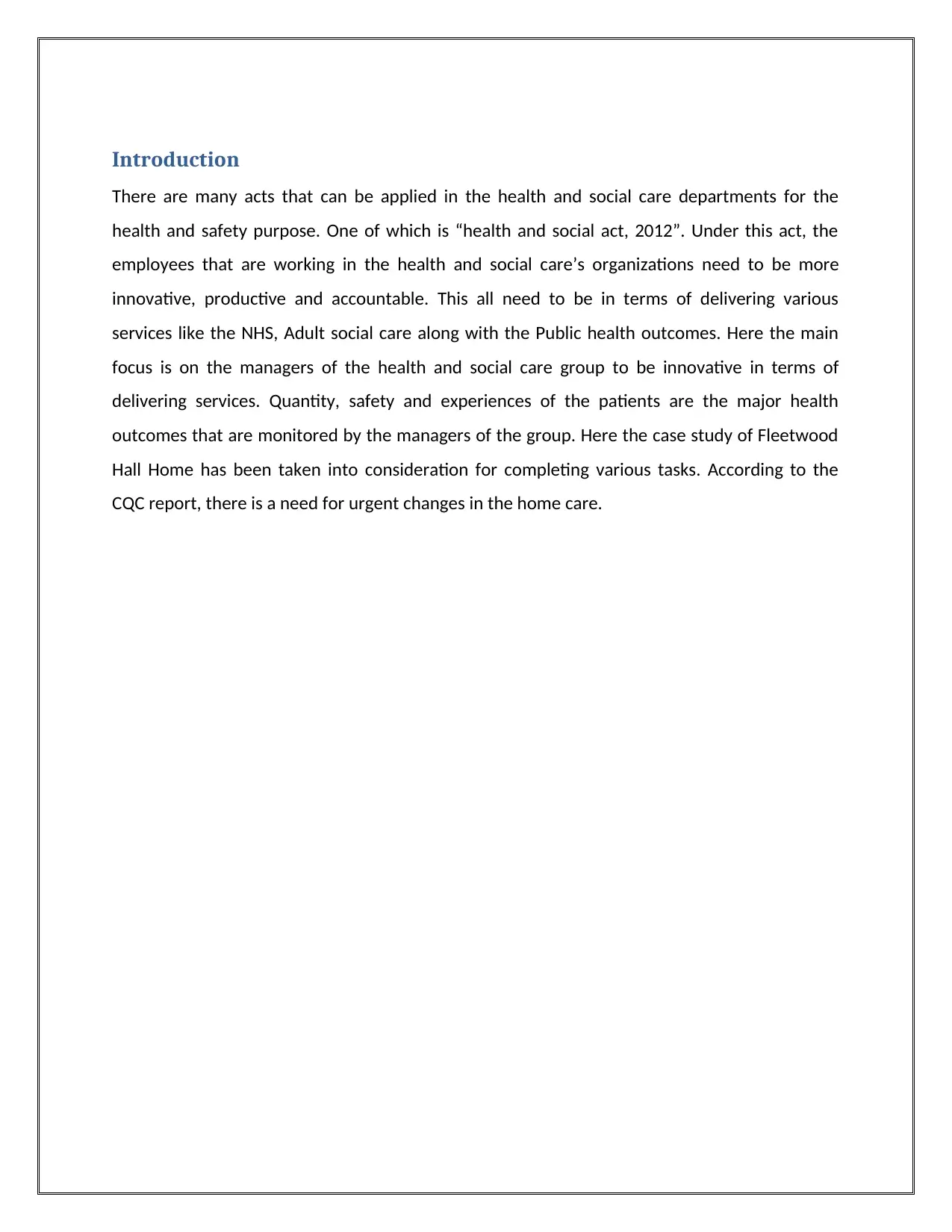
Introduction
There are many acts that can be applied in the health and social care departments for the
health and safety purpose. One of which is “health and social act, 2012”. Under this act, the
employees that are working in the health and social care’s organizations need to be more
innovative, productive and accountable. This all need to be in terms of delivering various
services like the NHS, Adult social care along with the Public health outcomes. Here the main
focus is on the managers of the health and social care group to be innovative in terms of
delivering services. Quantity, safety and experiences of the patients are the major health
outcomes that are monitored by the managers of the group. Here the case study of Fleetwood
Hall Home has been taken into consideration for completing various tasks. According to the
CQC report, there is a need for urgent changes in the home care.
There are many acts that can be applied in the health and social care departments for the
health and safety purpose. One of which is “health and social act, 2012”. Under this act, the
employees that are working in the health and social care’s organizations need to be more
innovative, productive and accountable. This all need to be in terms of delivering various
services like the NHS, Adult social care along with the Public health outcomes. Here the main
focus is on the managers of the health and social care group to be innovative in terms of
delivering services. Quantity, safety and experiences of the patients are the major health
outcomes that are monitored by the managers of the group. Here the case study of Fleetwood
Hall Home has been taken into consideration for completing various tasks. According to the
CQC report, there is a need for urgent changes in the home care.
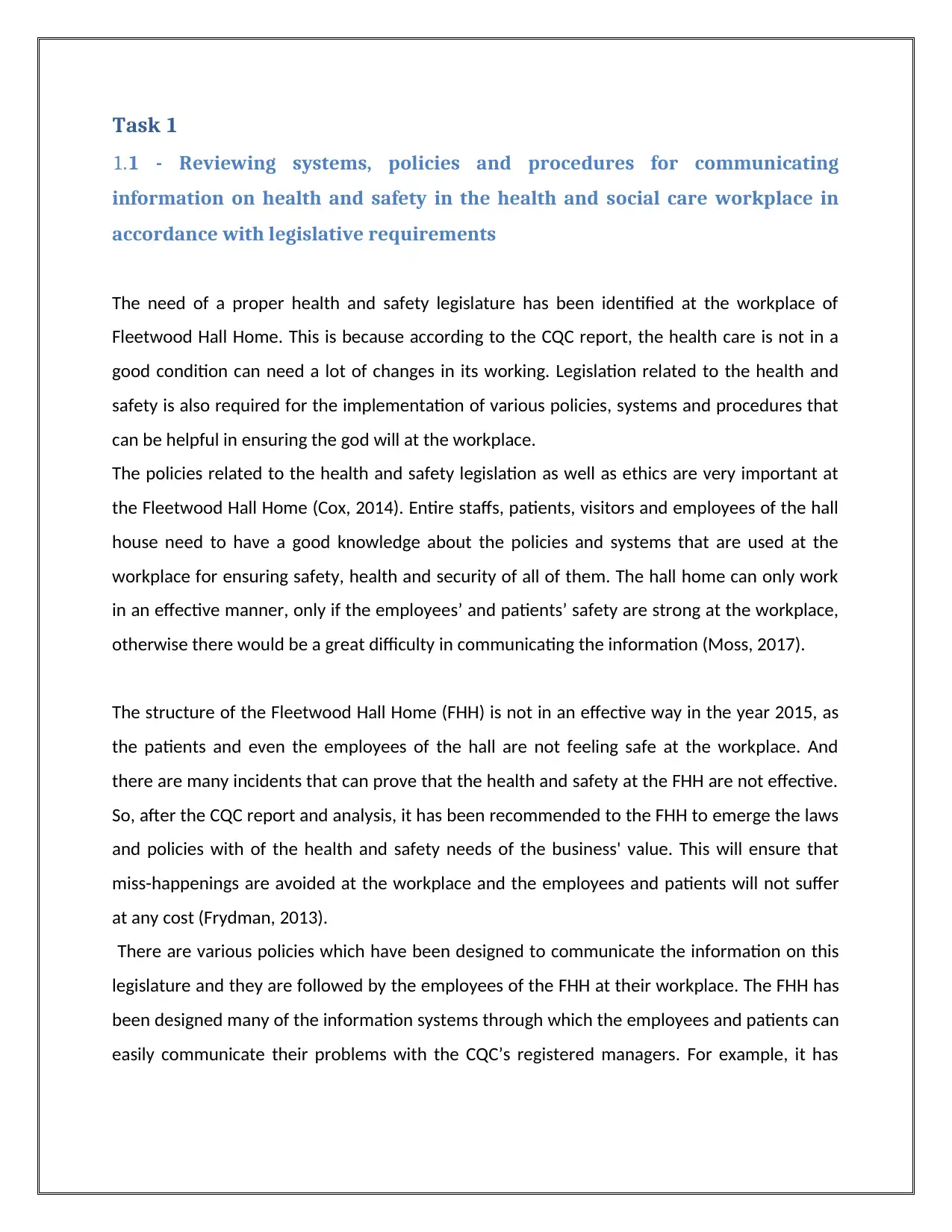
Task 1
1.1 - Reviewing systems, policies and procedures for communicating
information on health and safety in the health and social care workplace in
accordance with legislative requirements
The need of a proper health and safety legislature has been identified at the workplace of
Fleetwood Hall Home. This is because according to the CQC report, the health care is not in a
good condition can need a lot of changes in its working. Legislation related to the health and
safety is also required for the implementation of various policies, systems and procedures that
can be helpful in ensuring the god will at the workplace.
The policies related to the health and safety legislation as well as ethics are very important at
the Fleetwood Hall Home (Cox, 2014). Entire staffs, patients, visitors and employees of the hall
house need to have a good knowledge about the policies and systems that are used at the
workplace for ensuring safety, health and security of all of them. The hall home can only work
in an effective manner, only if the employees’ and patients’ safety are strong at the workplace,
otherwise there would be a great difficulty in communicating the information (Moss, 2017).
The structure of the Fleetwood Hall Home (FHH) is not in an effective way in the year 2015, as
the patients and even the employees of the hall are not feeling safe at the workplace. And
there are many incidents that can prove that the health and safety at the FHH are not effective.
So, after the CQC report and analysis, it has been recommended to the FHH to emerge the laws
and policies with of the health and safety needs of the business' value. This will ensure that
miss-happenings are avoided at the workplace and the employees and patients will not suffer
at any cost (Frydman, 2013).
There are various policies which have been designed to communicate the information on this
legislature and they are followed by the employees of the FHH at their workplace. The FHH has
been designed many of the information systems through which the employees and patients can
easily communicate their problems with the CQC’s registered managers. For example, it has
1.1 - Reviewing systems, policies and procedures for communicating
information on health and safety in the health and social care workplace in
accordance with legislative requirements
The need of a proper health and safety legislature has been identified at the workplace of
Fleetwood Hall Home. This is because according to the CQC report, the health care is not in a
good condition can need a lot of changes in its working. Legislation related to the health and
safety is also required for the implementation of various policies, systems and procedures that
can be helpful in ensuring the god will at the workplace.
The policies related to the health and safety legislation as well as ethics are very important at
the Fleetwood Hall Home (Cox, 2014). Entire staffs, patients, visitors and employees of the hall
house need to have a good knowledge about the policies and systems that are used at the
workplace for ensuring safety, health and security of all of them. The hall home can only work
in an effective manner, only if the employees’ and patients’ safety are strong at the workplace,
otherwise there would be a great difficulty in communicating the information (Moss, 2017).
The structure of the Fleetwood Hall Home (FHH) is not in an effective way in the year 2015, as
the patients and even the employees of the hall are not feeling safe at the workplace. And
there are many incidents that can prove that the health and safety at the FHH are not effective.
So, after the CQC report and analysis, it has been recommended to the FHH to emerge the laws
and policies with of the health and safety needs of the business' value. This will ensure that
miss-happenings are avoided at the workplace and the employees and patients will not suffer
at any cost (Frydman, 2013).
There are various policies which have been designed to communicate the information on this
legislature and they are followed by the employees of the FHH at their workplace. The FHH has
been designed many of the information systems through which the employees and patients can
easily communicate their problems with the CQC’s registered managers. For example, it has
Secure Best Marks with AI Grader
Need help grading? Try our AI Grader for instant feedback on your assignments.
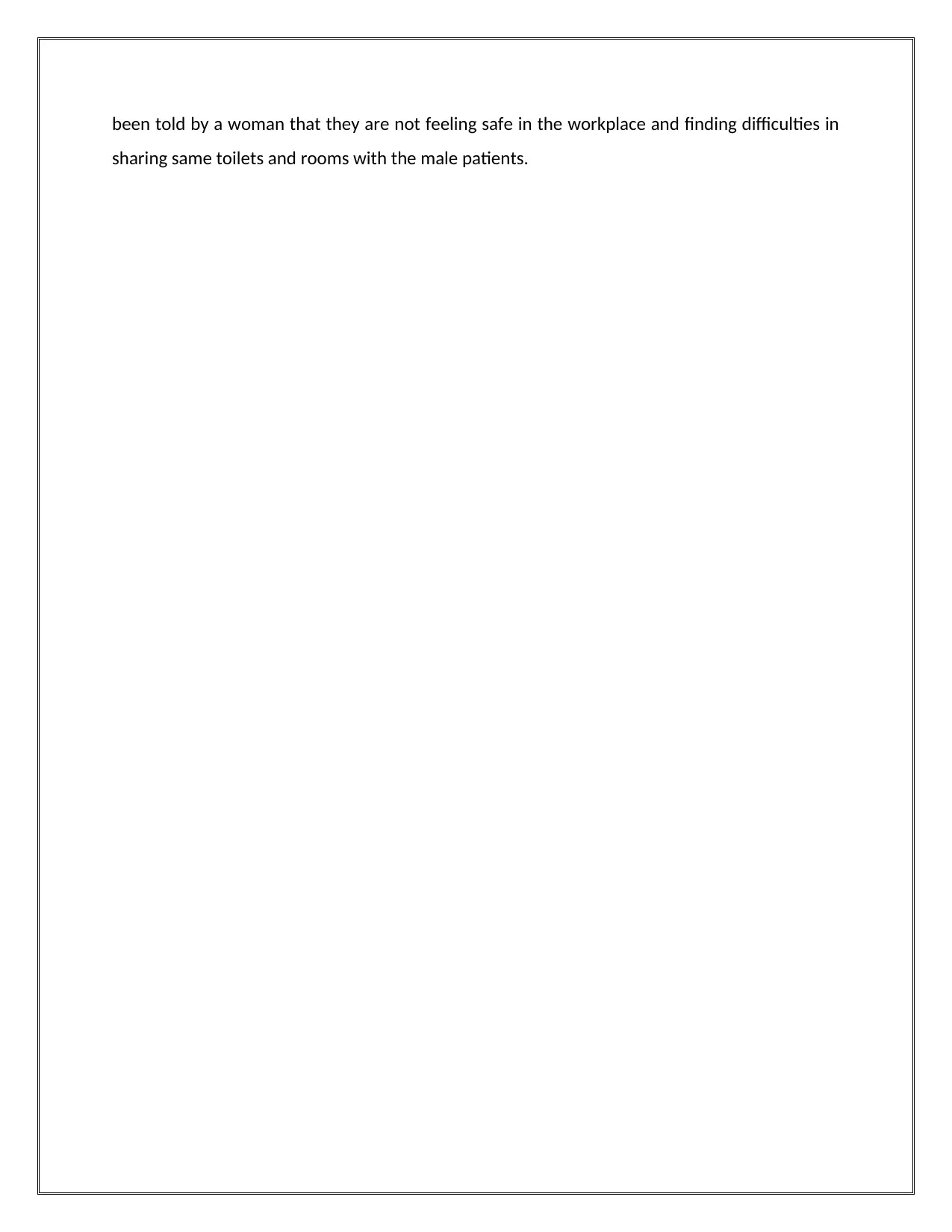
been told by a woman that they are not feeling safe in the workplace and finding difficulties in
sharing same toilets and rooms with the male patients.
sharing same toilets and rooms with the male patients.
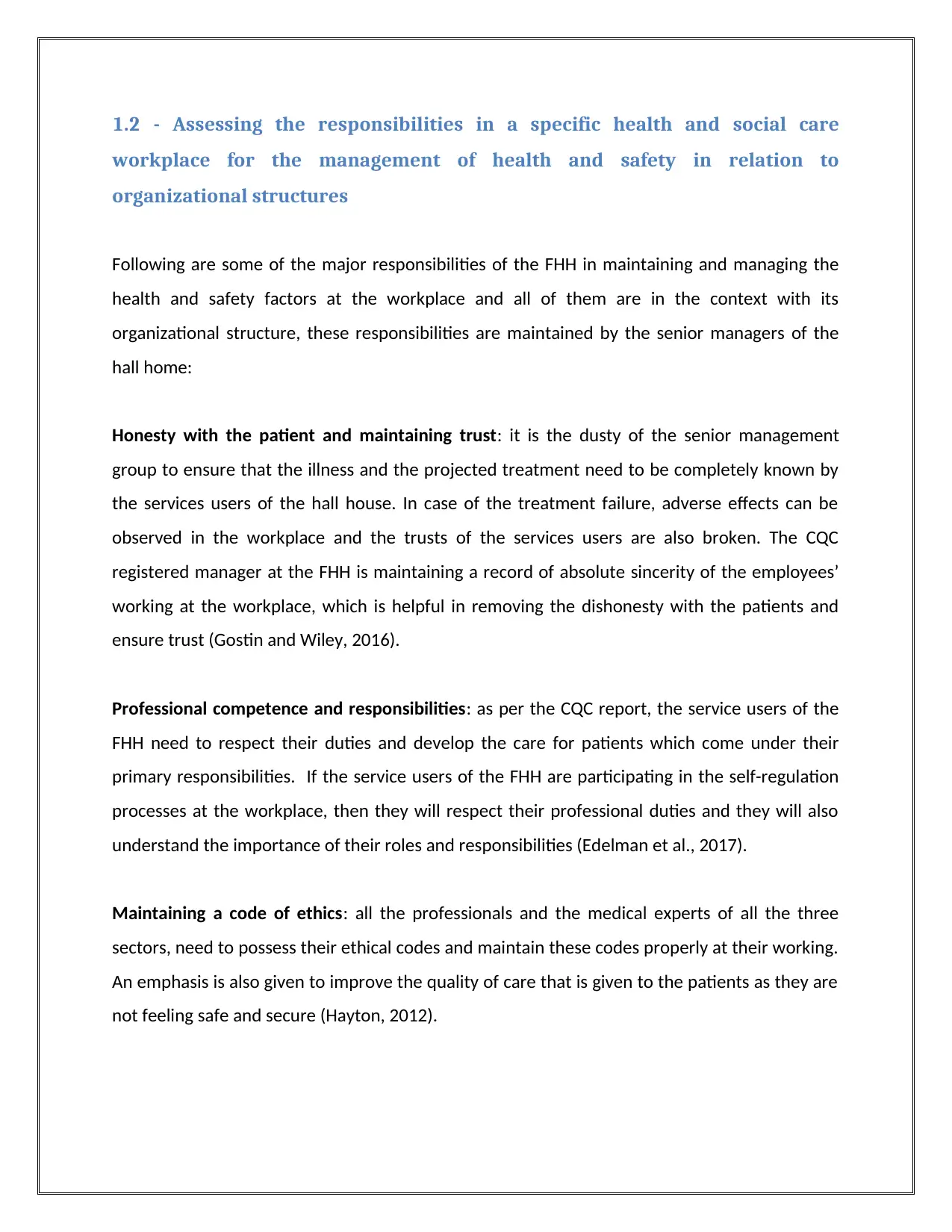
1.2 - Assessing the responsibilities in a specific health and social care
workplace for the management of health and safety in relation to
organizational structures
Following are some of the major responsibilities of the FHH in maintaining and managing the
health and safety factors at the workplace and all of them are in the context with its
organizational structure, these responsibilities are maintained by the senior managers of the
hall home:
Honesty with the patient and maintaining trust: it is the dusty of the senior management
group to ensure that the illness and the projected treatment need to be completely known by
the services users of the hall house. In case of the treatment failure, adverse effects can be
observed in the workplace and the trusts of the services users are also broken. The CQC
registered manager at the FHH is maintaining a record of absolute sincerity of the employees’
working at the workplace, which is helpful in removing the dishonesty with the patients and
ensure trust (Gostin and Wiley, 2016).
Professional competence and responsibilities: as per the CQC report, the service users of the
FHH need to respect their duties and develop the care for patients which come under their
primary responsibilities. If the service users of the FHH are participating in the self-regulation
processes at the workplace, then they will respect their professional duties and they will also
understand the importance of their roles and responsibilities (Edelman et al., 2017).
Maintaining a code of ethics: all the professionals and the medical experts of all the three
sectors, need to possess their ethical codes and maintain these codes properly at their working.
An emphasis is also given to improve the quality of care that is given to the patients as they are
not feeling safe and secure (Hayton, 2012).
workplace for the management of health and safety in relation to
organizational structures
Following are some of the major responsibilities of the FHH in maintaining and managing the
health and safety factors at the workplace and all of them are in the context with its
organizational structure, these responsibilities are maintained by the senior managers of the
hall home:
Honesty with the patient and maintaining trust: it is the dusty of the senior management
group to ensure that the illness and the projected treatment need to be completely known by
the services users of the hall house. In case of the treatment failure, adverse effects can be
observed in the workplace and the trusts of the services users are also broken. The CQC
registered manager at the FHH is maintaining a record of absolute sincerity of the employees’
working at the workplace, which is helpful in removing the dishonesty with the patients and
ensure trust (Gostin and Wiley, 2016).
Professional competence and responsibilities: as per the CQC report, the service users of the
FHH need to respect their duties and develop the care for patients which come under their
primary responsibilities. If the service users of the FHH are participating in the self-regulation
processes at the workplace, then they will respect their professional duties and they will also
understand the importance of their roles and responsibilities (Edelman et al., 2017).
Maintaining a code of ethics: all the professionals and the medical experts of all the three
sectors, need to possess their ethical codes and maintain these codes properly at their working.
An emphasis is also given to improve the quality of care that is given to the patients as they are
not feeling safe and secure (Hayton, 2012).

For example, the women of the hall home are not feeling safe while using the same toilets, so
the health care need to separate their belongings for improving the quality of care at the FHH's
workplace.
the health care need to separate their belongings for improving the quality of care at the FHH's
workplace.
Paraphrase This Document
Need a fresh take? Get an instant paraphrase of this document with our AI Paraphraser
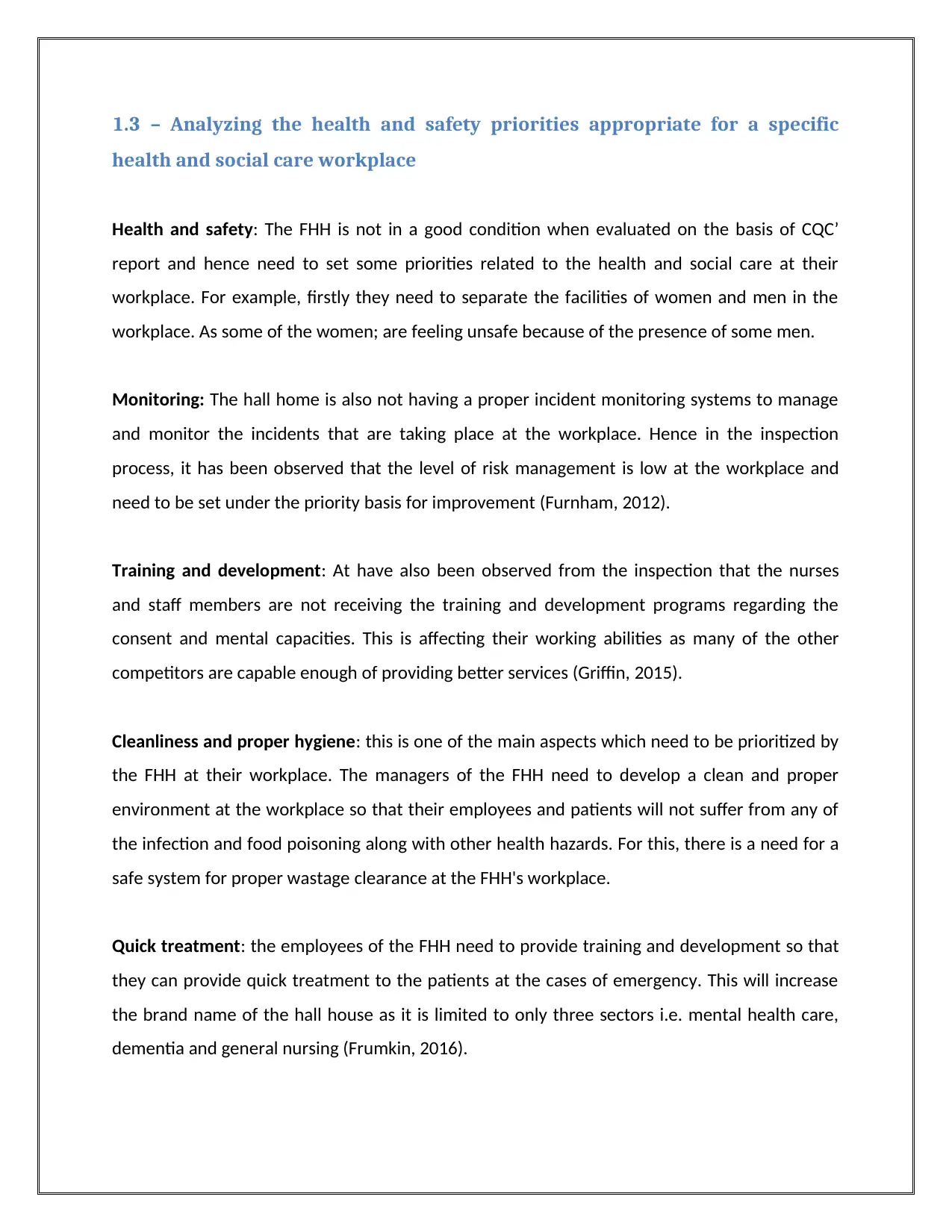
1.3 – Analyzing the health and safety priorities appropriate for a specific
health and social care workplace
Health and safety: The FHH is not in a good condition when evaluated on the basis of CQC’
report and hence need to set some priorities related to the health and social care at their
workplace. For example, firstly they need to separate the facilities of women and men in the
workplace. As some of the women; are feeling unsafe because of the presence of some men.
Monitoring: The hall home is also not having a proper incident monitoring systems to manage
and monitor the incidents that are taking place at the workplace. Hence in the inspection
process, it has been observed that the level of risk management is low at the workplace and
need to be set under the priority basis for improvement (Furnham, 2012).
Training and development: At have also been observed from the inspection that the nurses
and staff members are not receiving the training and development programs regarding the
consent and mental capacities. This is affecting their working abilities as many of the other
competitors are capable enough of providing better services (Griffin, 2015).
Cleanliness and proper hygiene: this is one of the main aspects which need to be prioritized by
the FHH at their workplace. The managers of the FHH need to develop a clean and proper
environment at the workplace so that their employees and patients will not suffer from any of
the infection and food poisoning along with other health hazards. For this, there is a need for a
safe system for proper wastage clearance at the FHH's workplace.
Quick treatment: the employees of the FHH need to provide training and development so that
they can provide quick treatment to the patients at the cases of emergency. This will increase
the brand name of the hall house as it is limited to only three sectors i.e. mental health care,
dementia and general nursing (Frumkin, 2016).
health and social care workplace
Health and safety: The FHH is not in a good condition when evaluated on the basis of CQC’
report and hence need to set some priorities related to the health and social care at their
workplace. For example, firstly they need to separate the facilities of women and men in the
workplace. As some of the women; are feeling unsafe because of the presence of some men.
Monitoring: The hall home is also not having a proper incident monitoring systems to manage
and monitor the incidents that are taking place at the workplace. Hence in the inspection
process, it has been observed that the level of risk management is low at the workplace and
need to be set under the priority basis for improvement (Furnham, 2012).
Training and development: At have also been observed from the inspection that the nurses
and staff members are not receiving the training and development programs regarding the
consent and mental capacities. This is affecting their working abilities as many of the other
competitors are capable enough of providing better services (Griffin, 2015).
Cleanliness and proper hygiene: this is one of the main aspects which need to be prioritized by
the FHH at their workplace. The managers of the FHH need to develop a clean and proper
environment at the workplace so that their employees and patients will not suffer from any of
the infection and food poisoning along with other health hazards. For this, there is a need for a
safe system for proper wastage clearance at the FHH's workplace.
Quick treatment: the employees of the FHH need to provide training and development so that
they can provide quick treatment to the patients at the cases of emergency. This will increase
the brand name of the hall house as it is limited to only three sectors i.e. mental health care,
dementia and general nursing (Frumkin, 2016).
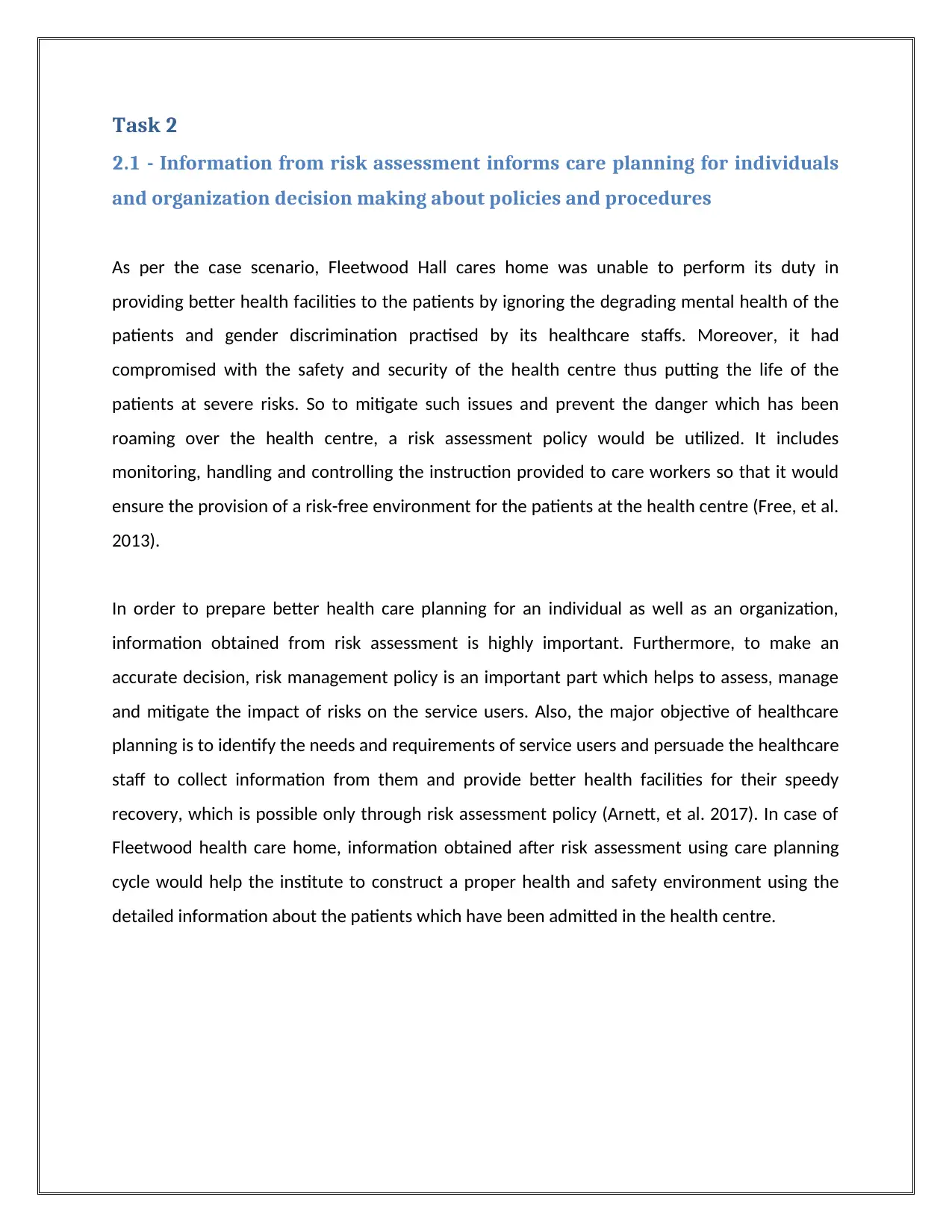
Task 2
2.1 - Information from risk assessment informs care planning for individuals
and organization decision making about policies and procedures
As per the case scenario, Fleetwood Hall cares home was unable to perform its duty in
providing better health facilities to the patients by ignoring the degrading mental health of the
patients and gender discrimination practised by its healthcare staffs. Moreover, it had
compromised with the safety and security of the health centre thus putting the life of the
patients at severe risks. So to mitigate such issues and prevent the danger which has been
roaming over the health centre, a risk assessment policy would be utilized. It includes
monitoring, handling and controlling the instruction provided to care workers so that it would
ensure the provision of a risk-free environment for the patients at the health centre (Free, et al.
2013).
In order to prepare better health care planning for an individual as well as an organization,
information obtained from risk assessment is highly important. Furthermore, to make an
accurate decision, risk management policy is an important part which helps to assess, manage
and mitigate the impact of risks on the service users. Also, the major objective of healthcare
planning is to identify the needs and requirements of service users and persuade the healthcare
staff to collect information from them and provide better health facilities for their speedy
recovery, which is possible only through risk assessment policy (Arnett, et al. 2017). In case of
Fleetwood health care home, information obtained after risk assessment using care planning
cycle would help the institute to construct a proper health and safety environment using the
detailed information about the patients which have been admitted in the health centre.
2.1 - Information from risk assessment informs care planning for individuals
and organization decision making about policies and procedures
As per the case scenario, Fleetwood Hall cares home was unable to perform its duty in
providing better health facilities to the patients by ignoring the degrading mental health of the
patients and gender discrimination practised by its healthcare staffs. Moreover, it had
compromised with the safety and security of the health centre thus putting the life of the
patients at severe risks. So to mitigate such issues and prevent the danger which has been
roaming over the health centre, a risk assessment policy would be utilized. It includes
monitoring, handling and controlling the instruction provided to care workers so that it would
ensure the provision of a risk-free environment for the patients at the health centre (Free, et al.
2013).
In order to prepare better health care planning for an individual as well as an organization,
information obtained from risk assessment is highly important. Furthermore, to make an
accurate decision, risk management policy is an important part which helps to assess, manage
and mitigate the impact of risks on the service users. Also, the major objective of healthcare
planning is to identify the needs and requirements of service users and persuade the healthcare
staff to collect information from them and provide better health facilities for their speedy
recovery, which is possible only through risk assessment policy (Arnett, et al. 2017). In case of
Fleetwood health care home, information obtained after risk assessment using care planning
cycle would help the institute to construct a proper health and safety environment using the
detailed information about the patients which have been admitted in the health centre.
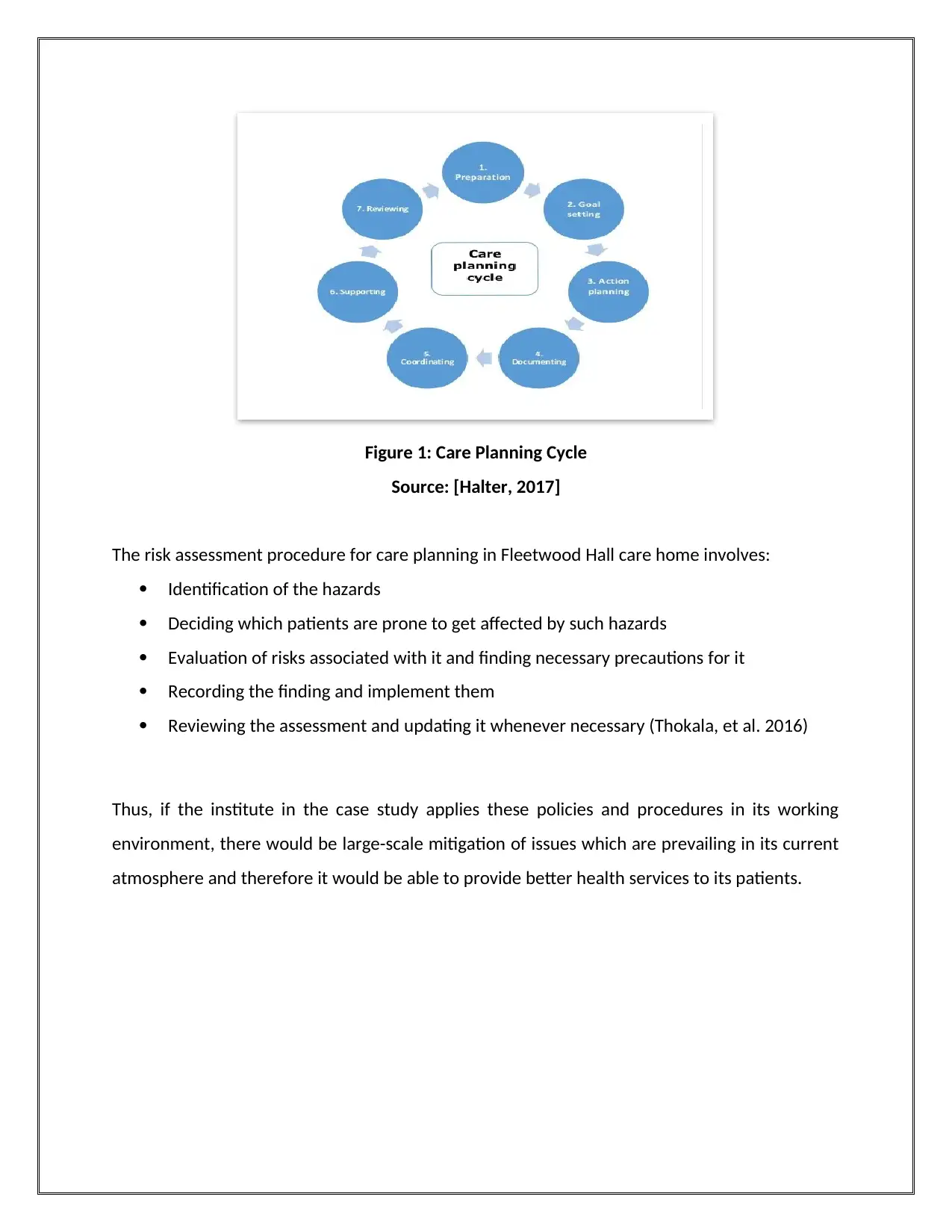
Figure 1: Care Planning Cycle
Source: [Halter, 2017]
The risk assessment procedure for care planning in Fleetwood Hall care home involves:
Identification of the hazards
Deciding which patients are prone to get affected by such hazards
Evaluation of risks associated with it and finding necessary precautions for it
Recording the finding and implement them
Reviewing the assessment and updating it whenever necessary (Thokala, et al. 2016)
Thus, if the institute in the case study applies these policies and procedures in its working
environment, there would be large-scale mitigation of issues which are prevailing in its current
atmosphere and therefore it would be able to provide better health services to its patients.
Source: [Halter, 2017]
The risk assessment procedure for care planning in Fleetwood Hall care home involves:
Identification of the hazards
Deciding which patients are prone to get affected by such hazards
Evaluation of risks associated with it and finding necessary precautions for it
Recording the finding and implement them
Reviewing the assessment and updating it whenever necessary (Thokala, et al. 2016)
Thus, if the institute in the case study applies these policies and procedures in its working
environment, there would be large-scale mitigation of issues which are prevailing in its current
atmosphere and therefore it would be able to provide better health services to its patients.
Secure Best Marks with AI Grader
Need help grading? Try our AI Grader for instant feedback on your assignments.
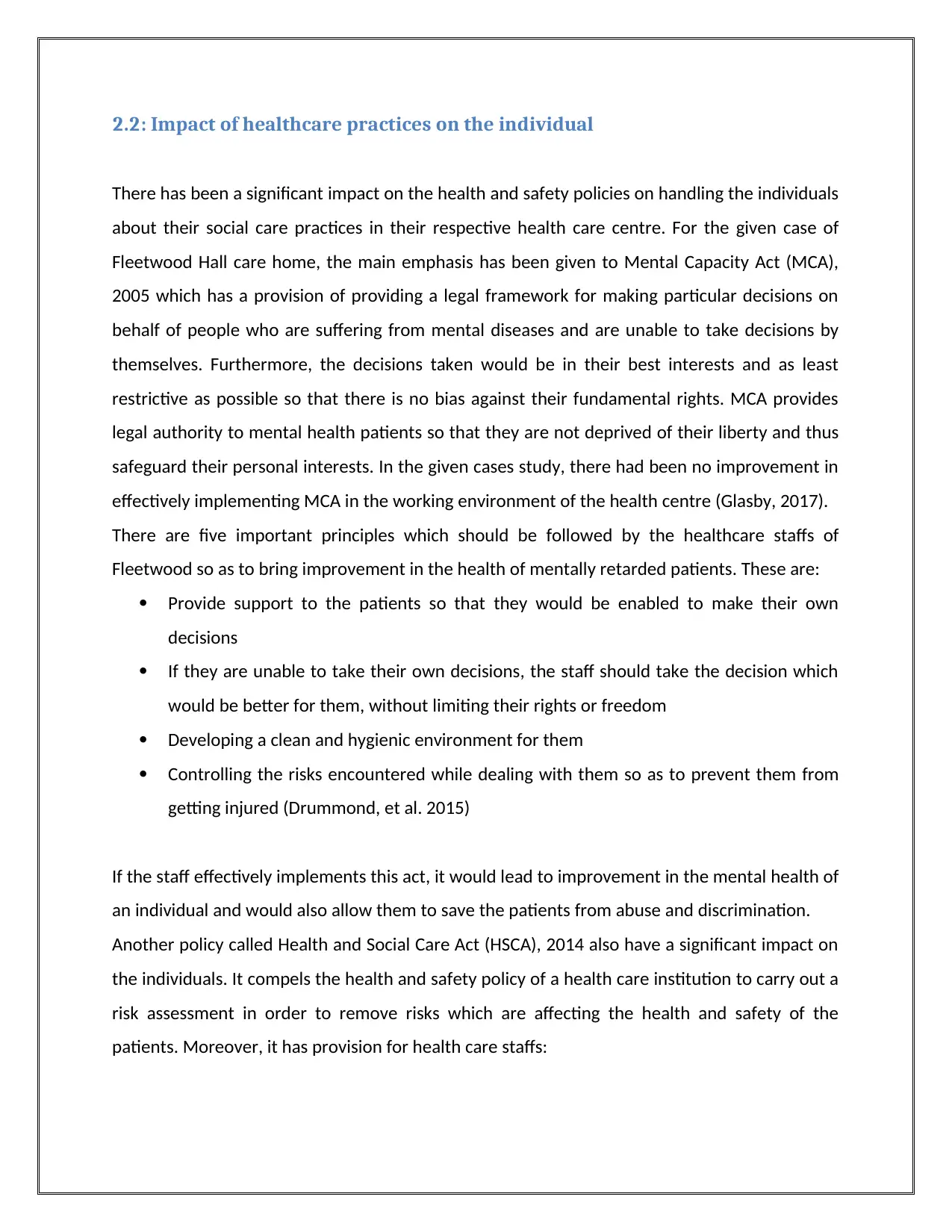
2.2: Impact of healthcare practices on the individual
There has been a significant impact on the health and safety policies on handling the individuals
about their social care practices in their respective health care centre. For the given case of
Fleetwood Hall care home, the main emphasis has been given to Mental Capacity Act (MCA),
2005 which has a provision of providing a legal framework for making particular decisions on
behalf of people who are suffering from mental diseases and are unable to take decisions by
themselves. Furthermore, the decisions taken would be in their best interests and as least
restrictive as possible so that there is no bias against their fundamental rights. MCA provides
legal authority to mental health patients so that they are not deprived of their liberty and thus
safeguard their personal interests. In the given cases study, there had been no improvement in
effectively implementing MCA in the working environment of the health centre (Glasby, 2017).
There are five important principles which should be followed by the healthcare staffs of
Fleetwood so as to bring improvement in the health of mentally retarded patients. These are:
Provide support to the patients so that they would be enabled to make their own
decisions
If they are unable to take their own decisions, the staff should take the decision which
would be better for them, without limiting their rights or freedom
Developing a clean and hygienic environment for them
Controlling the risks encountered while dealing with them so as to prevent them from
getting injured (Drummond, et al. 2015)
If the staff effectively implements this act, it would lead to improvement in the mental health of
an individual and would also allow them to save the patients from abuse and discrimination.
Another policy called Health and Social Care Act (HSCA), 2014 also have a significant impact on
the individuals. It compels the health and safety policy of a health care institution to carry out a
risk assessment in order to remove risks which are affecting the health and safety of the
patients. Moreover, it has provision for health care staffs:
There has been a significant impact on the health and safety policies on handling the individuals
about their social care practices in their respective health care centre. For the given case of
Fleetwood Hall care home, the main emphasis has been given to Mental Capacity Act (MCA),
2005 which has a provision of providing a legal framework for making particular decisions on
behalf of people who are suffering from mental diseases and are unable to take decisions by
themselves. Furthermore, the decisions taken would be in their best interests and as least
restrictive as possible so that there is no bias against their fundamental rights. MCA provides
legal authority to mental health patients so that they are not deprived of their liberty and thus
safeguard their personal interests. In the given cases study, there had been no improvement in
effectively implementing MCA in the working environment of the health centre (Glasby, 2017).
There are five important principles which should be followed by the healthcare staffs of
Fleetwood so as to bring improvement in the health of mentally retarded patients. These are:
Provide support to the patients so that they would be enabled to make their own
decisions
If they are unable to take their own decisions, the staff should take the decision which
would be better for them, without limiting their rights or freedom
Developing a clean and hygienic environment for them
Controlling the risks encountered while dealing with them so as to prevent them from
getting injured (Drummond, et al. 2015)
If the staff effectively implements this act, it would lead to improvement in the mental health of
an individual and would also allow them to save the patients from abuse and discrimination.
Another policy called Health and Social Care Act (HSCA), 2014 also have a significant impact on
the individuals. It compels the health and safety policy of a health care institution to carry out a
risk assessment in order to remove risks which are affecting the health and safety of the
patients. Moreover, it has provision for health care staffs:
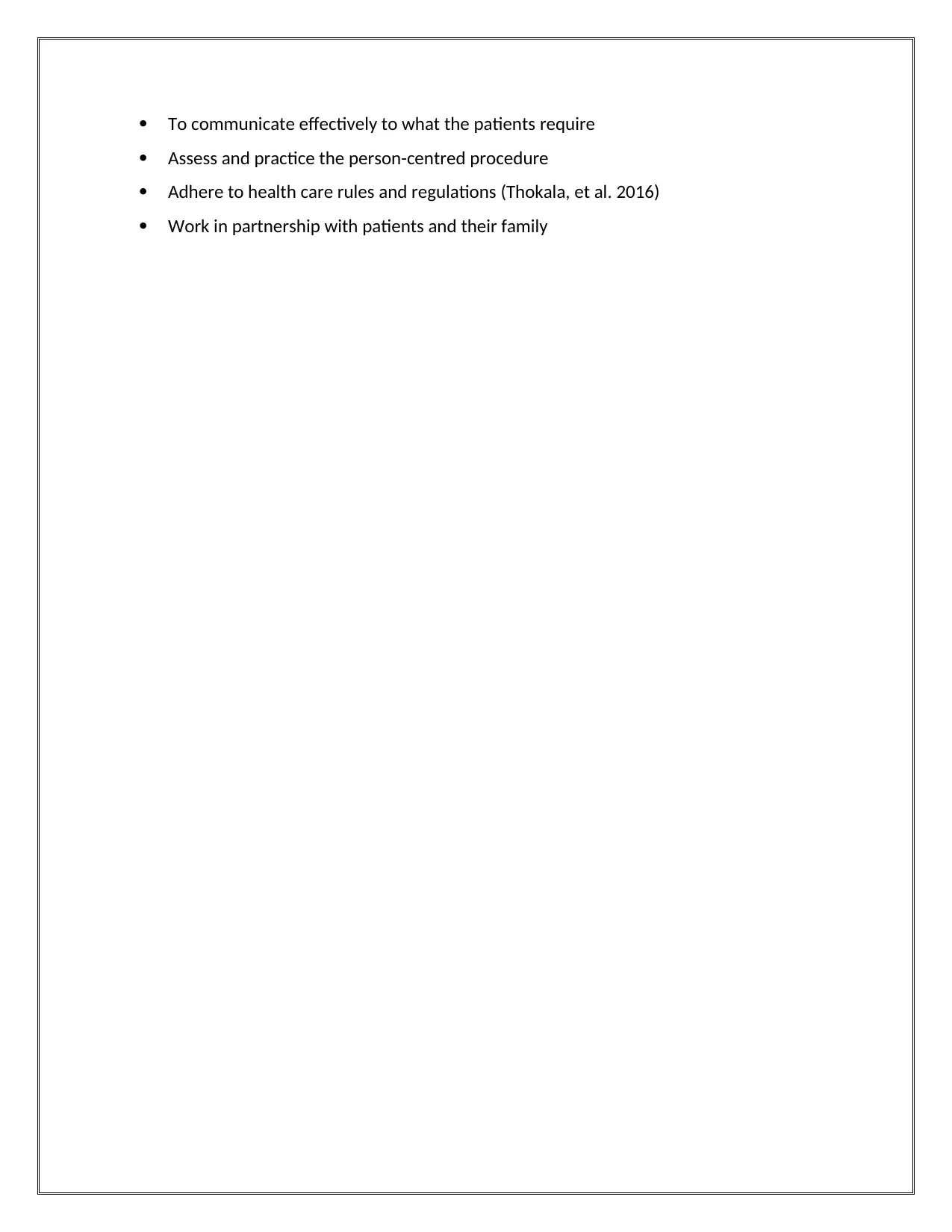
To communicate effectively to what the patients require
Assess and practice the person-centred procedure
Adhere to health care rules and regulations (Thokala, et al. 2016)
Work in partnership with patients and their family
Assess and practice the person-centred procedure
Adhere to health care rules and regulations (Thokala, et al. 2016)
Work in partnership with patients and their family
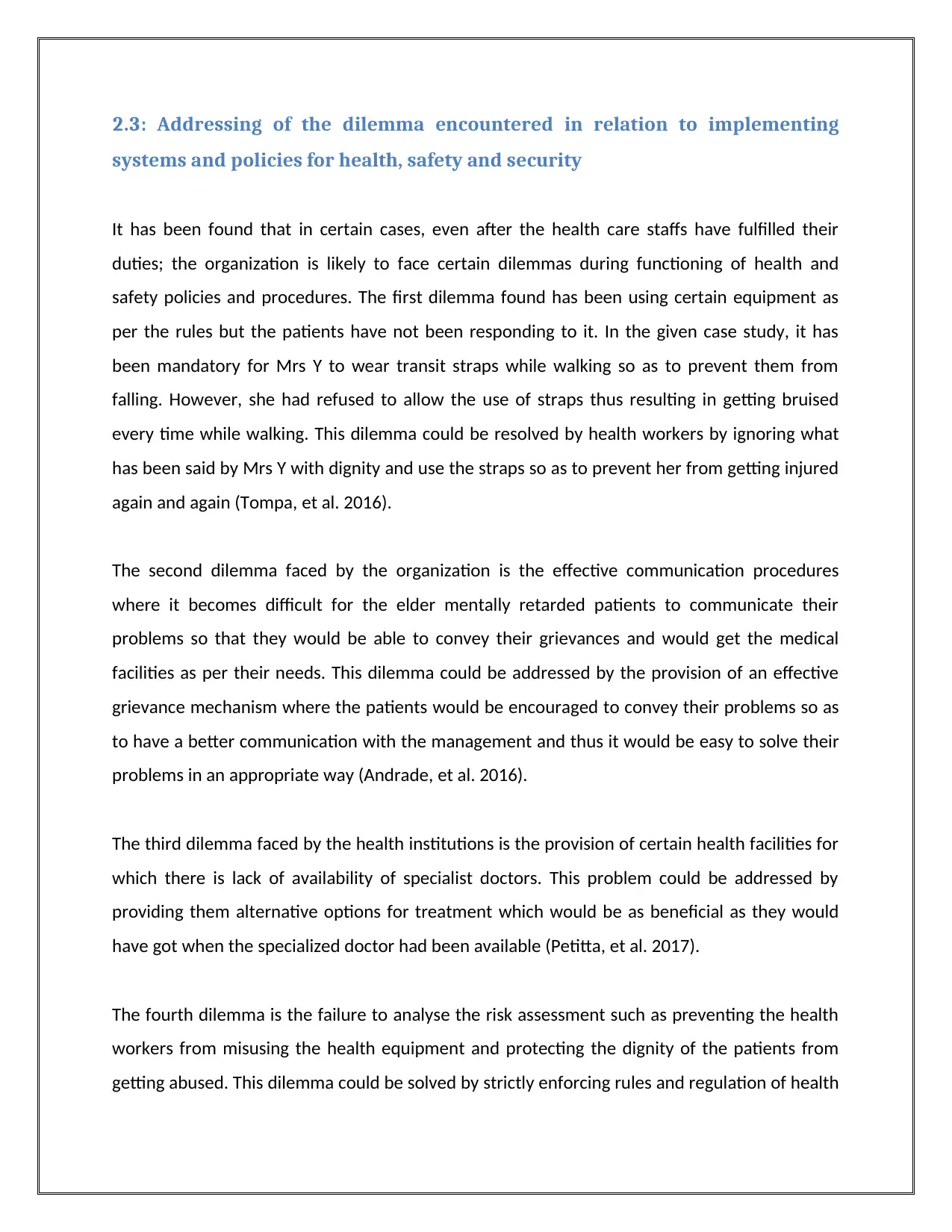
2.3: Addressing of the dilemma encountered in relation to implementing
systems and policies for health, safety and security
It has been found that in certain cases, even after the health care staffs have fulfilled their
duties; the organization is likely to face certain dilemmas during functioning of health and
safety policies and procedures. The first dilemma found has been using certain equipment as
per the rules but the patients have not been responding to it. In the given case study, it has
been mandatory for Mrs Y to wear transit straps while walking so as to prevent them from
falling. However, she had refused to allow the use of straps thus resulting in getting bruised
every time while walking. This dilemma could be resolved by health workers by ignoring what
has been said by Mrs Y with dignity and use the straps so as to prevent her from getting injured
again and again (Tompa, et al. 2016).
The second dilemma faced by the organization is the effective communication procedures
where it becomes difficult for the elder mentally retarded patients to communicate their
problems so that they would be able to convey their grievances and would get the medical
facilities as per their needs. This dilemma could be addressed by the provision of an effective
grievance mechanism where the patients would be encouraged to convey their problems so as
to have a better communication with the management and thus it would be easy to solve their
problems in an appropriate way (Andrade, et al. 2016).
The third dilemma faced by the health institutions is the provision of certain health facilities for
which there is lack of availability of specialist doctors. This problem could be addressed by
providing them alternative options for treatment which would be as beneficial as they would
have got when the specialized doctor had been available (Petitta, et al. 2017).
The fourth dilemma is the failure to analyse the risk assessment such as preventing the health
workers from misusing the health equipment and protecting the dignity of the patients from
getting abused. This dilemma could be solved by strictly enforcing rules and regulation of health
systems and policies for health, safety and security
It has been found that in certain cases, even after the health care staffs have fulfilled their
duties; the organization is likely to face certain dilemmas during functioning of health and
safety policies and procedures. The first dilemma found has been using certain equipment as
per the rules but the patients have not been responding to it. In the given case study, it has
been mandatory for Mrs Y to wear transit straps while walking so as to prevent them from
falling. However, she had refused to allow the use of straps thus resulting in getting bruised
every time while walking. This dilemma could be resolved by health workers by ignoring what
has been said by Mrs Y with dignity and use the straps so as to prevent her from getting injured
again and again (Tompa, et al. 2016).
The second dilemma faced by the organization is the effective communication procedures
where it becomes difficult for the elder mentally retarded patients to communicate their
problems so that they would be able to convey their grievances and would get the medical
facilities as per their needs. This dilemma could be addressed by the provision of an effective
grievance mechanism where the patients would be encouraged to convey their problems so as
to have a better communication with the management and thus it would be easy to solve their
problems in an appropriate way (Andrade, et al. 2016).
The third dilemma faced by the health institutions is the provision of certain health facilities for
which there is lack of availability of specialist doctors. This problem could be addressed by
providing them alternative options for treatment which would be as beneficial as they would
have got when the specialized doctor had been available (Petitta, et al. 2017).
The fourth dilemma is the failure to analyse the risk assessment such as preventing the health
workers from misusing the health equipment and protecting the dignity of the patients from
getting abused. This dilemma could be solved by strictly enforcing rules and regulation of health
Paraphrase This Document
Need a fresh take? Get an instant paraphrase of this document with our AI Paraphraser
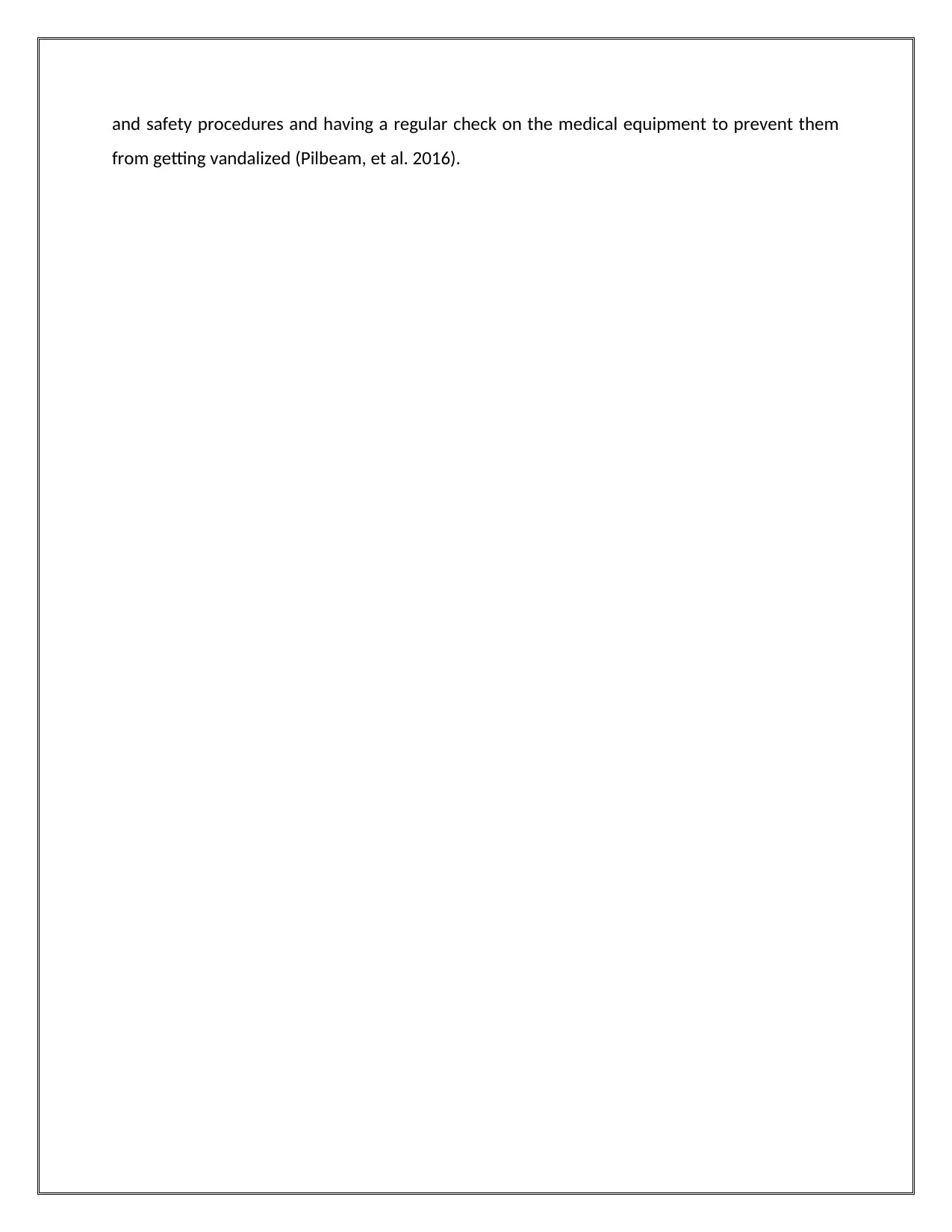
and safety procedures and having a regular check on the medical equipment to prevent them
from getting vandalized (Pilbeam, et al. 2016).
from getting vandalized (Pilbeam, et al. 2016).
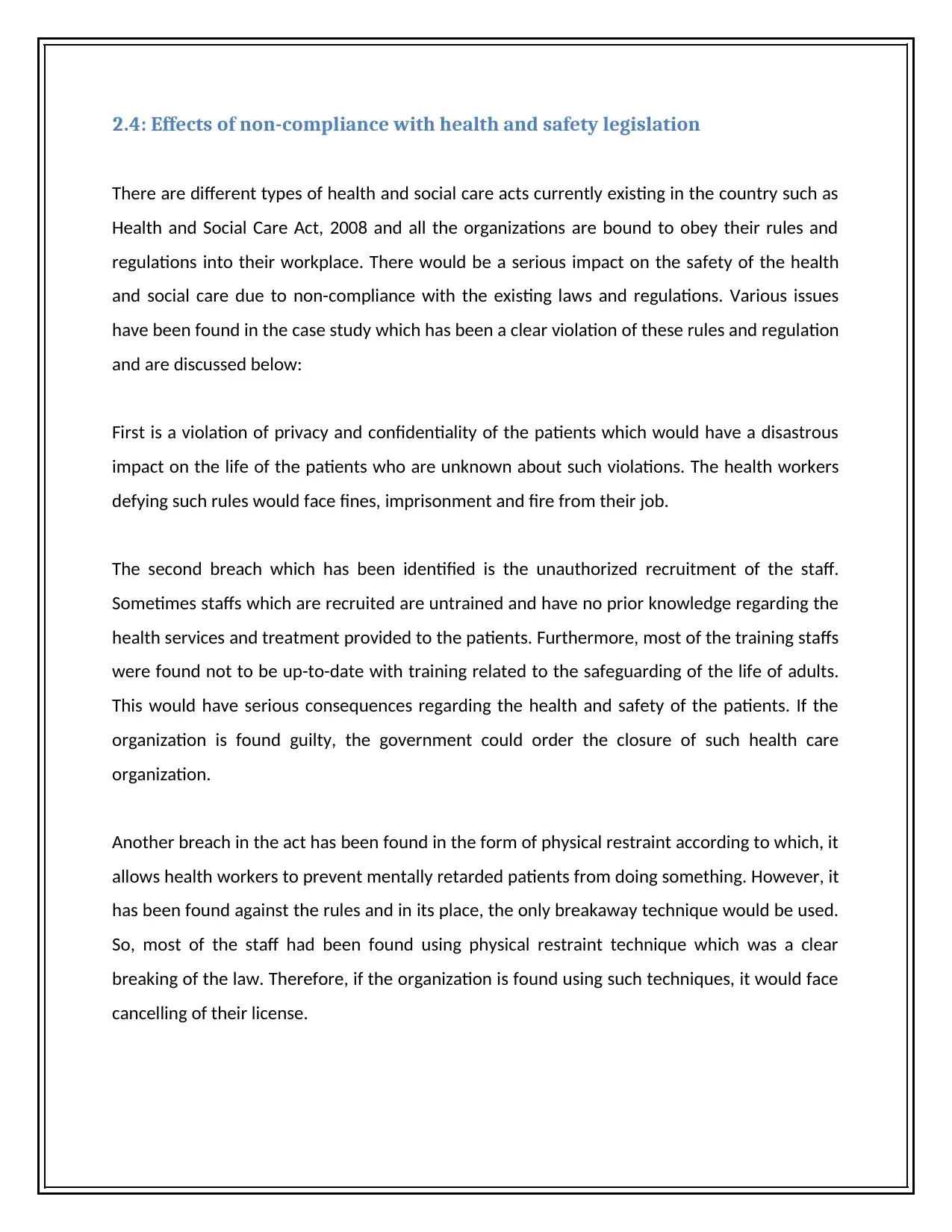
2.4: Effects of non-compliance with health and safety legislation
There are different types of health and social care acts currently existing in the country such as
Health and Social Care Act, 2008 and all the organizations are bound to obey their rules and
regulations into their workplace. There would be a serious impact on the safety of the health
and social care due to non-compliance with the existing laws and regulations. Various issues
have been found in the case study which has been a clear violation of these rules and regulation
and are discussed below:
First is a violation of privacy and confidentiality of the patients which would have a disastrous
impact on the life of the patients who are unknown about such violations. The health workers
defying such rules would face fines, imprisonment and fire from their job.
The second breach which has been identified is the unauthorized recruitment of the staff.
Sometimes staffs which are recruited are untrained and have no prior knowledge regarding the
health services and treatment provided to the patients. Furthermore, most of the training staffs
were found not to be up-to-date with training related to the safeguarding of the life of adults.
This would have serious consequences regarding the health and safety of the patients. If the
organization is found guilty, the government could order the closure of such health care
organization.
Another breach in the act has been found in the form of physical restraint according to which, it
allows health workers to prevent mentally retarded patients from doing something. However, it
has been found against the rules and in its place, the only breakaway technique would be used.
So, most of the staff had been found using physical restraint technique which was a clear
breaking of the law. Therefore, if the organization is found using such techniques, it would face
cancelling of their license.
There are different types of health and social care acts currently existing in the country such as
Health and Social Care Act, 2008 and all the organizations are bound to obey their rules and
regulations into their workplace. There would be a serious impact on the safety of the health
and social care due to non-compliance with the existing laws and regulations. Various issues
have been found in the case study which has been a clear violation of these rules and regulation
and are discussed below:
First is a violation of privacy and confidentiality of the patients which would have a disastrous
impact on the life of the patients who are unknown about such violations. The health workers
defying such rules would face fines, imprisonment and fire from their job.
The second breach which has been identified is the unauthorized recruitment of the staff.
Sometimes staffs which are recruited are untrained and have no prior knowledge regarding the
health services and treatment provided to the patients. Furthermore, most of the training staffs
were found not to be up-to-date with training related to the safeguarding of the life of adults.
This would have serious consequences regarding the health and safety of the patients. If the
organization is found guilty, the government could order the closure of such health care
organization.
Another breach in the act has been found in the form of physical restraint according to which, it
allows health workers to prevent mentally retarded patients from doing something. However, it
has been found against the rules and in its place, the only breakaway technique would be used.
So, most of the staff had been found using physical restraint technique which was a clear
breaking of the law. Therefore, if the organization is found using such techniques, it would face
cancelling of their license.
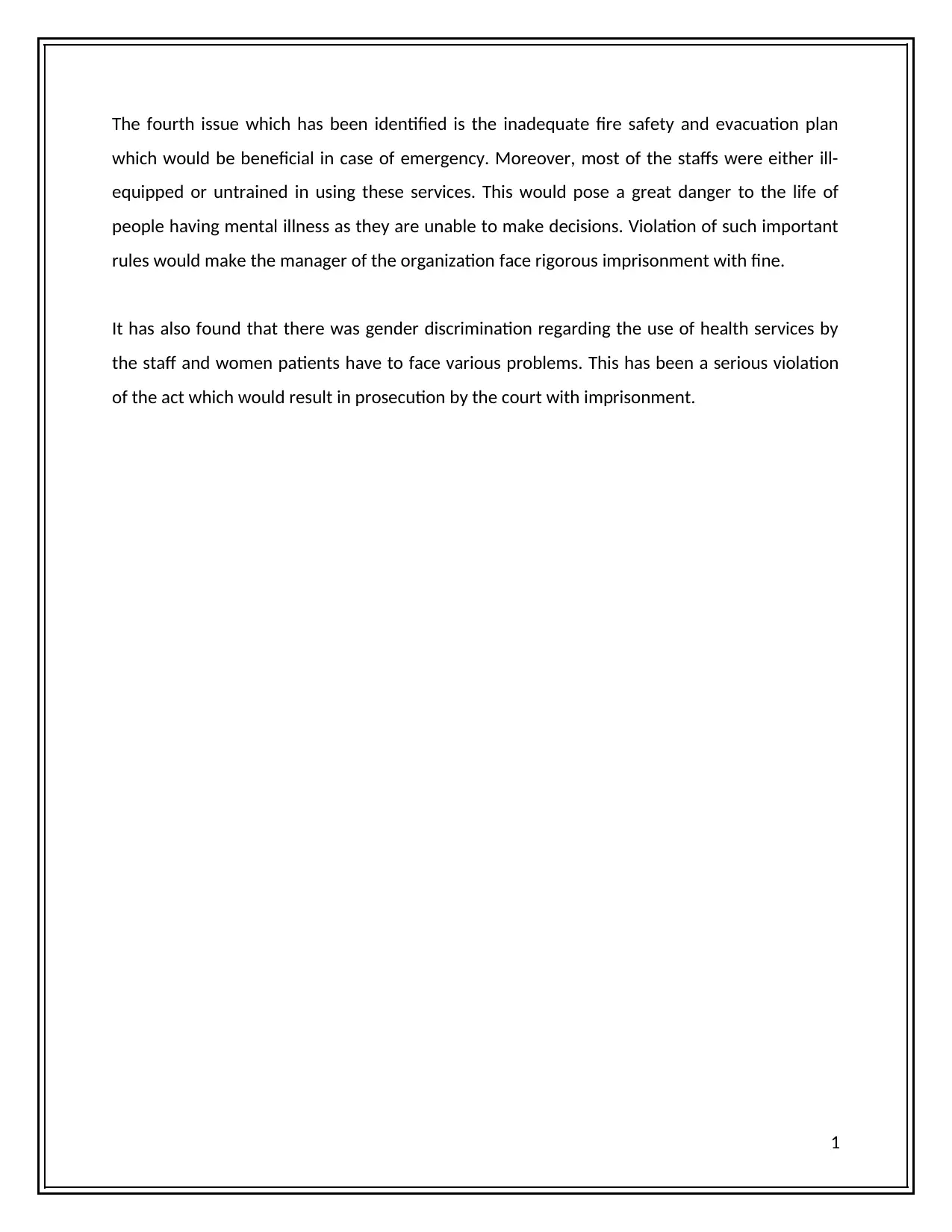
The fourth issue which has been identified is the inadequate fire safety and evacuation plan
which would be beneficial in case of emergency. Moreover, most of the staffs were either ill-
equipped or untrained in using these services. This would pose a great danger to the life of
people having mental illness as they are unable to make decisions. Violation of such important
rules would make the manager of the organization face rigorous imprisonment with fine.
It has also found that there was gender discrimination regarding the use of health services by
the staff and women patients have to face various problems. This has been a serious violation
of the act which would result in prosecution by the court with imprisonment.
1
which would be beneficial in case of emergency. Moreover, most of the staffs were either ill-
equipped or untrained in using these services. This would pose a great danger to the life of
people having mental illness as they are unable to make decisions. Violation of such important
rules would make the manager of the organization face rigorous imprisonment with fine.
It has also found that there was gender discrimination regarding the use of health services by
the staff and women patients have to face various problems. This has been a serious violation
of the act which would result in prosecution by the court with imprisonment.
1
Secure Best Marks with AI Grader
Need help grading? Try our AI Grader for instant feedback on your assignments.
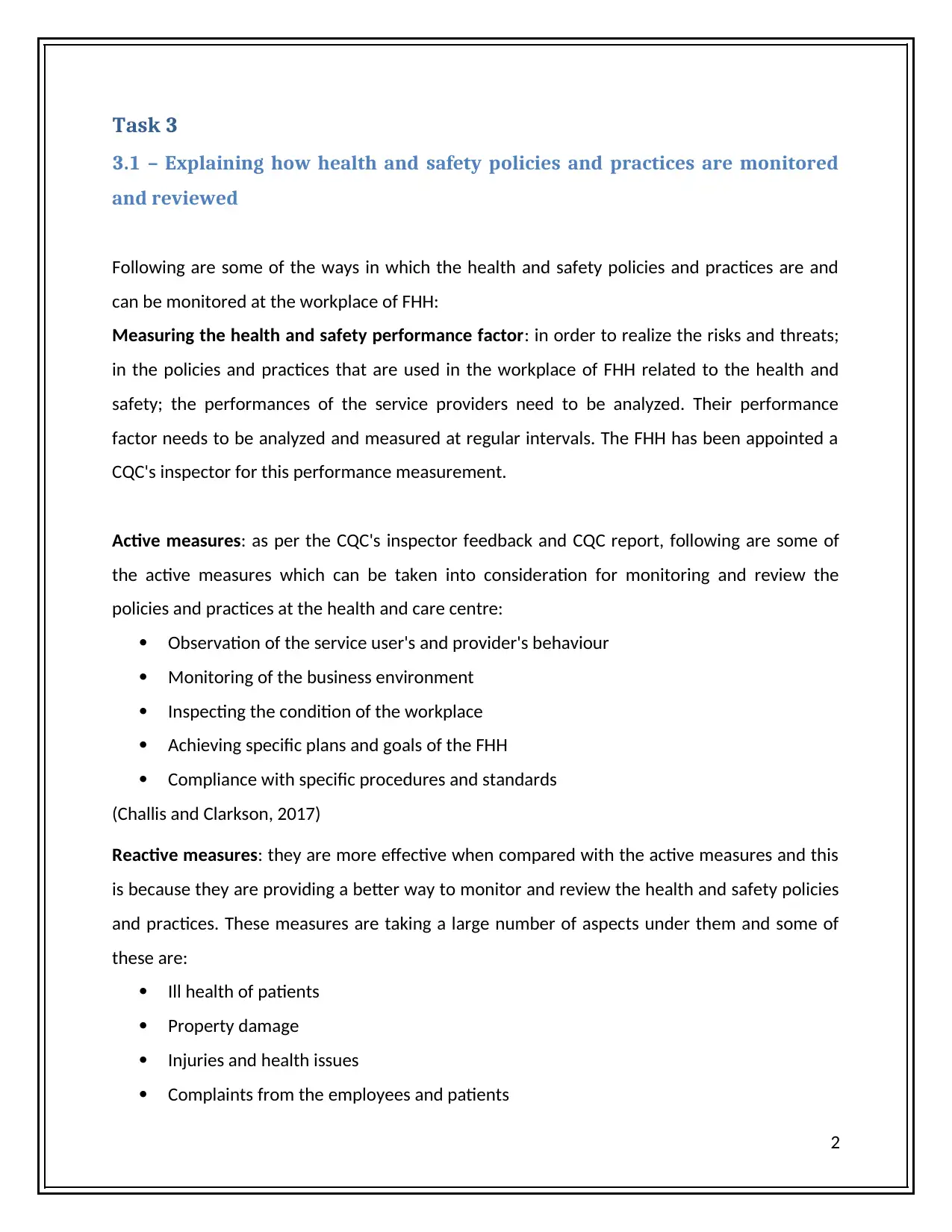
Task 3
3.1 – Explaining how health and safety policies and practices are monitored
and reviewed
Following are some of the ways in which the health and safety policies and practices are and
can be monitored at the workplace of FHH:
Measuring the health and safety performance factor: in order to realize the risks and threats;
in the policies and practices that are used in the workplace of FHH related to the health and
safety; the performances of the service providers need to be analyzed. Their performance
factor needs to be analyzed and measured at regular intervals. The FHH has been appointed a
CQC's inspector for this performance measurement.
Active measures: as per the CQC's inspector feedback and CQC report, following are some of
the active measures which can be taken into consideration for monitoring and review the
policies and practices at the health and care centre:
Observation of the service user's and provider's behaviour
Monitoring of the business environment
Inspecting the condition of the workplace
Achieving specific plans and goals of the FHH
Compliance with specific procedures and standards
(Challis and Clarkson, 2017)
Reactive measures: they are more effective when compared with the active measures and this
is because they are providing a better way to monitor and review the health and safety policies
and practices. These measures are taking a large number of aspects under them and some of
these are:
Ill health of patients
Property damage
Injuries and health issues
Complaints from the employees and patients
2
3.1 – Explaining how health and safety policies and practices are monitored
and reviewed
Following are some of the ways in which the health and safety policies and practices are and
can be monitored at the workplace of FHH:
Measuring the health and safety performance factor: in order to realize the risks and threats;
in the policies and practices that are used in the workplace of FHH related to the health and
safety; the performances of the service providers need to be analyzed. Their performance
factor needs to be analyzed and measured at regular intervals. The FHH has been appointed a
CQC's inspector for this performance measurement.
Active measures: as per the CQC's inspector feedback and CQC report, following are some of
the active measures which can be taken into consideration for monitoring and review the
policies and practices at the health and care centre:
Observation of the service user's and provider's behaviour
Monitoring of the business environment
Inspecting the condition of the workplace
Achieving specific plans and goals of the FHH
Compliance with specific procedures and standards
(Challis and Clarkson, 2017)
Reactive measures: they are more effective when compared with the active measures and this
is because they are providing a better way to monitor and review the health and safety policies
and practices. These measures are taking a large number of aspects under them and some of
these are:
Ill health of patients
Property damage
Injuries and health issues
Complaints from the employees and patients
2

Inspections: in this, the physical pieces of evidence are observed at the workplace of FHH in
order to monitor the health and safety parameters. The CQC inspector and managers are
dedicated at the FHH for the inspection and carrying about various activities for the betterment
of health and safety measures. For example, they have separated the toilet and staying facilities
of the women and men at the workplace due to which many of the women are now feeling
secure at the FHH’s premises (Glasby, 2017). Facilities for the first-aid, floor, passages welfare
etc. are the primary focus of the inspection processes at the health care.
3
order to monitor the health and safety parameters. The CQC inspector and managers are
dedicated at the FHH for the inspection and carrying about various activities for the betterment
of health and safety measures. For example, they have separated the toilet and staying facilities
of the women and men at the workplace due to which many of the women are now feeling
secure at the FHH’s premises (Glasby, 2017). Facilities for the first-aid, floor, passages welfare
etc. are the primary focus of the inspection processes at the health care.
3
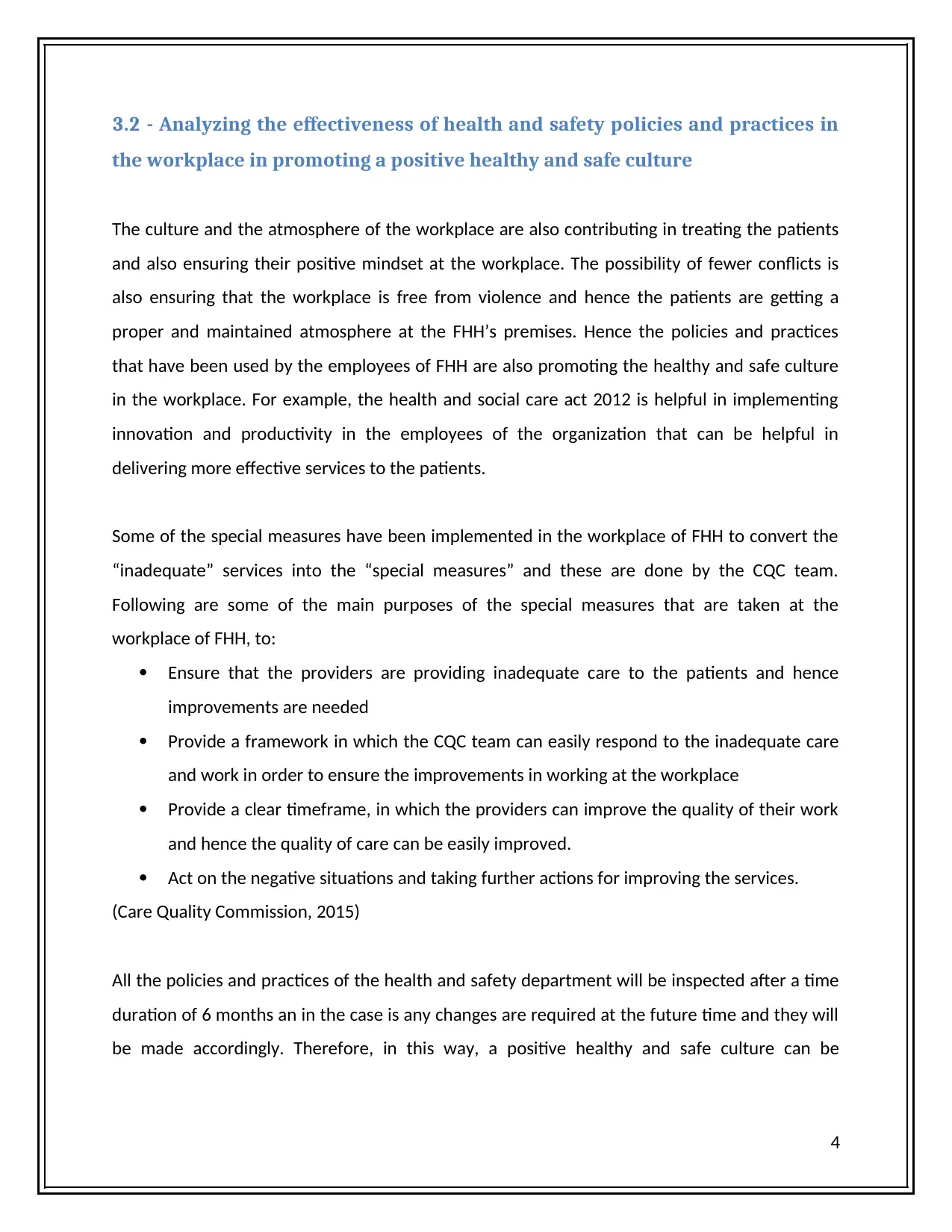
3.2 - Analyzing the effectiveness of health and safety policies and practices in
the workplace in promoting a positive healthy and safe culture
The culture and the atmosphere of the workplace are also contributing in treating the patients
and also ensuring their positive mindset at the workplace. The possibility of fewer conflicts is
also ensuring that the workplace is free from violence and hence the patients are getting a
proper and maintained atmosphere at the FHH’s premises. Hence the policies and practices
that have been used by the employees of FHH are also promoting the healthy and safe culture
in the workplace. For example, the health and social care act 2012 is helpful in implementing
innovation and productivity in the employees of the organization that can be helpful in
delivering more effective services to the patients.
Some of the special measures have been implemented in the workplace of FHH to convert the
“inadequate” services into the “special measures” and these are done by the CQC team.
Following are some of the main purposes of the special measures that are taken at the
workplace of FHH, to:
Ensure that the providers are providing inadequate care to the patients and hence
improvements are needed
Provide a framework in which the CQC team can easily respond to the inadequate care
and work in order to ensure the improvements in working at the workplace
Provide a clear timeframe, in which the providers can improve the quality of their work
and hence the quality of care can be easily improved.
Act on the negative situations and taking further actions for improving the services.
(Care Quality Commission, 2015)
All the policies and practices of the health and safety department will be inspected after a time
duration of 6 months an in the case is any changes are required at the future time and they will
be made accordingly. Therefore, in this way, a positive healthy and safe culture can be
4
the workplace in promoting a positive healthy and safe culture
The culture and the atmosphere of the workplace are also contributing in treating the patients
and also ensuring their positive mindset at the workplace. The possibility of fewer conflicts is
also ensuring that the workplace is free from violence and hence the patients are getting a
proper and maintained atmosphere at the FHH’s premises. Hence the policies and practices
that have been used by the employees of FHH are also promoting the healthy and safe culture
in the workplace. For example, the health and social care act 2012 is helpful in implementing
innovation and productivity in the employees of the organization that can be helpful in
delivering more effective services to the patients.
Some of the special measures have been implemented in the workplace of FHH to convert the
“inadequate” services into the “special measures” and these are done by the CQC team.
Following are some of the main purposes of the special measures that are taken at the
workplace of FHH, to:
Ensure that the providers are providing inadequate care to the patients and hence
improvements are needed
Provide a framework in which the CQC team can easily respond to the inadequate care
and work in order to ensure the improvements in working at the workplace
Provide a clear timeframe, in which the providers can improve the quality of their work
and hence the quality of care can be easily improved.
Act on the negative situations and taking further actions for improving the services.
(Care Quality Commission, 2015)
All the policies and practices of the health and safety department will be inspected after a time
duration of 6 months an in the case is any changes are required at the future time and they will
be made accordingly. Therefore, in this way, a positive healthy and safe culture can be
4
Paraphrase This Document
Need a fresh take? Get an instant paraphrase of this document with our AI Paraphraser
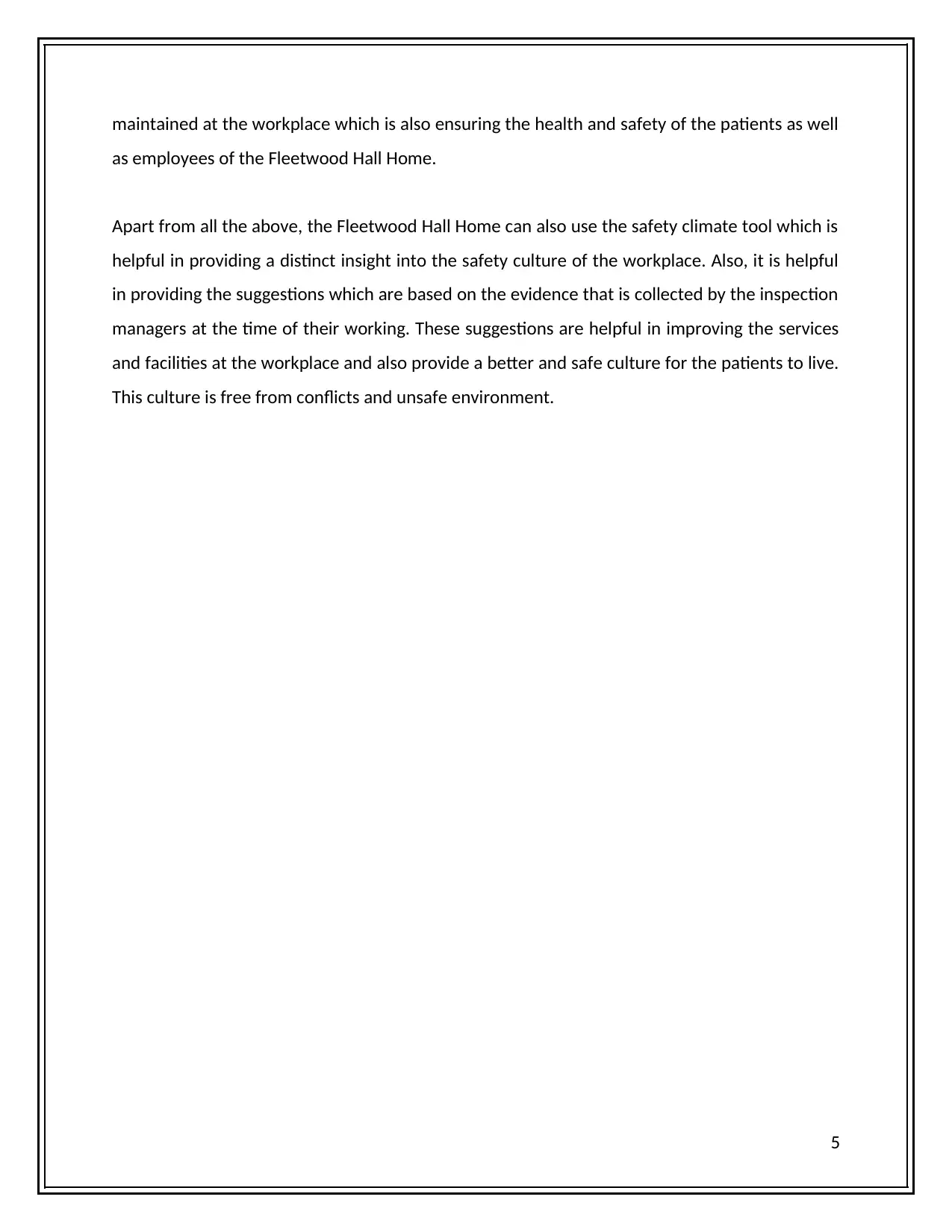
maintained at the workplace which is also ensuring the health and safety of the patients as well
as employees of the Fleetwood Hall Home.
Apart from all the above, the Fleetwood Hall Home can also use the safety climate tool which is
helpful in providing a distinct insight into the safety culture of the workplace. Also, it is helpful
in providing the suggestions which are based on the evidence that is collected by the inspection
managers at the time of their working. These suggestions are helpful in improving the services
and facilities at the workplace and also provide a better and safe culture for the patients to live.
This culture is free from conflicts and unsafe environment.
5
as employees of the Fleetwood Hall Home.
Apart from all the above, the Fleetwood Hall Home can also use the safety climate tool which is
helpful in providing a distinct insight into the safety culture of the workplace. Also, it is helpful
in providing the suggestions which are based on the evidence that is collected by the inspection
managers at the time of their working. These suggestions are helpful in improving the services
and facilities at the workplace and also provide a better and safe culture for the patients to live.
This culture is free from conflicts and unsafe environment.
5
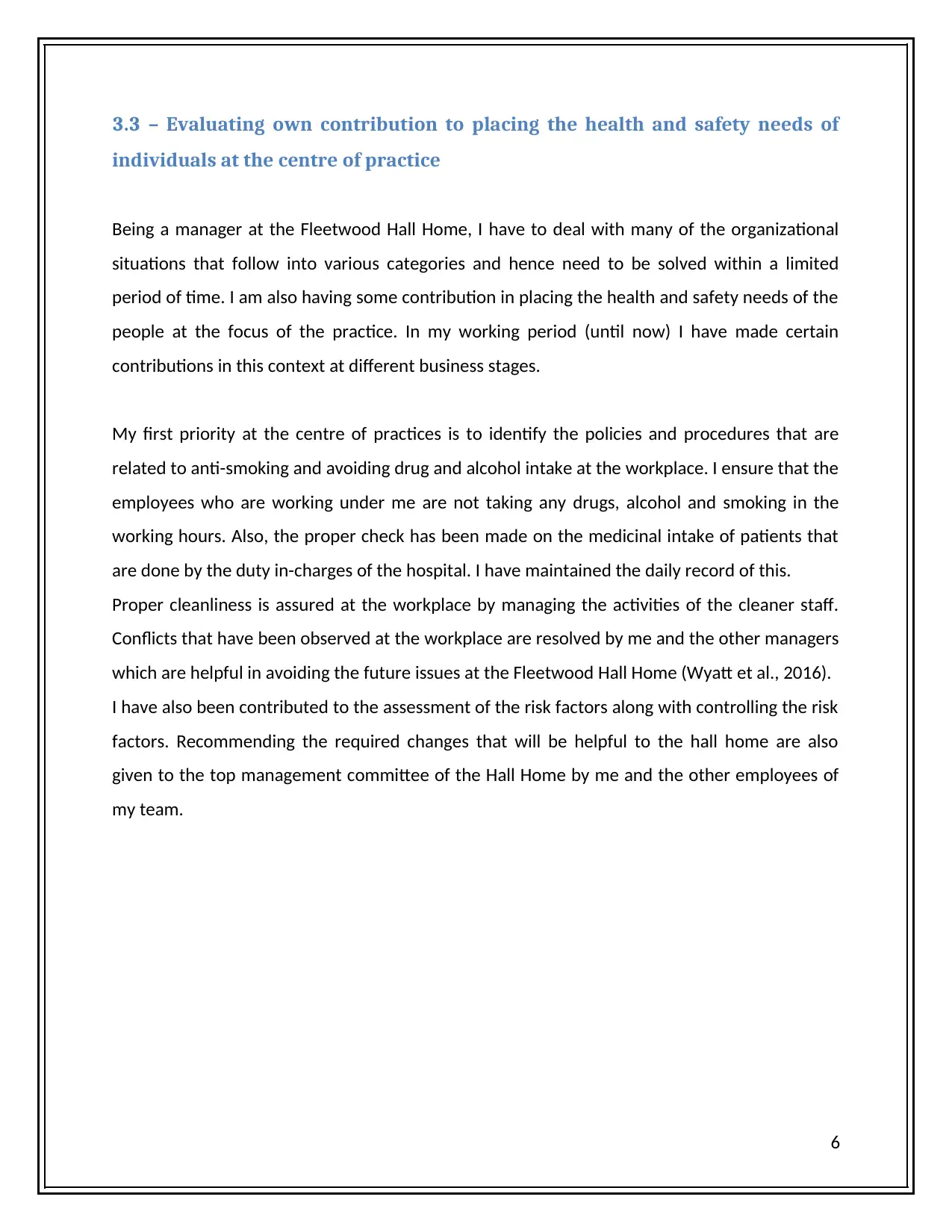
3.3 – Evaluating own contribution to placing the health and safety needs of
individuals at the centre of practice
Being a manager at the Fleetwood Hall Home, I have to deal with many of the organizational
situations that follow into various categories and hence need to be solved within a limited
period of time. I am also having some contribution in placing the health and safety needs of the
people at the focus of the practice. In my working period (until now) I have made certain
contributions in this context at different business stages.
My first priority at the centre of practices is to identify the policies and procedures that are
related to anti-smoking and avoiding drug and alcohol intake at the workplace. I ensure that the
employees who are working under me are not taking any drugs, alcohol and smoking in the
working hours. Also, the proper check has been made on the medicinal intake of patients that
are done by the duty in-charges of the hospital. I have maintained the daily record of this.
Proper cleanliness is assured at the workplace by managing the activities of the cleaner staff.
Conflicts that have been observed at the workplace are resolved by me and the other managers
which are helpful in avoiding the future issues at the Fleetwood Hall Home (Wyatt et al., 2016).
I have also been contributed to the assessment of the risk factors along with controlling the risk
factors. Recommending the required changes that will be helpful to the hall home are also
given to the top management committee of the Hall Home by me and the other employees of
my team.
6
individuals at the centre of practice
Being a manager at the Fleetwood Hall Home, I have to deal with many of the organizational
situations that follow into various categories and hence need to be solved within a limited
period of time. I am also having some contribution in placing the health and safety needs of the
people at the focus of the practice. In my working period (until now) I have made certain
contributions in this context at different business stages.
My first priority at the centre of practices is to identify the policies and procedures that are
related to anti-smoking and avoiding drug and alcohol intake at the workplace. I ensure that the
employees who are working under me are not taking any drugs, alcohol and smoking in the
working hours. Also, the proper check has been made on the medicinal intake of patients that
are done by the duty in-charges of the hospital. I have maintained the daily record of this.
Proper cleanliness is assured at the workplace by managing the activities of the cleaner staff.
Conflicts that have been observed at the workplace are resolved by me and the other managers
which are helpful in avoiding the future issues at the Fleetwood Hall Home (Wyatt et al., 2016).
I have also been contributed to the assessment of the risk factors along with controlling the risk
factors. Recommending the required changes that will be helpful to the hall home are also
given to the top management committee of the Hall Home by me and the other employees of
my team.
6

Conclusion
This assignment is al above the discussion of the health and safety in the Fleetwood Hall Home.
According to the CQC report, the technologies need to be developed at the workplace and
positive alteration need to be made at the workplace for the betterment of the services and
products at the workplace. Thus the study was able to provide the utilization of risk assessment
in care planning for the patients admitted in the Fleetwood Hall care home. The study also
assessed the care planning cycle and how it was effectively utilized by the health centre.
Furthermore, the study found a significant impact of various health care policies and revealed
that if they are properly utilized; it would be beneficial for the health centre. Some dilemmas
related to implementing these policies and procedures were thoroughly discussed and a
suitable solution was also addressed. At last, the effects of non-compliance with health and
safety legislation was analyzed and its consequences for the given health centre was presented
in an appropriate manner.
7
This assignment is al above the discussion of the health and safety in the Fleetwood Hall Home.
According to the CQC report, the technologies need to be developed at the workplace and
positive alteration need to be made at the workplace for the betterment of the services and
products at the workplace. Thus the study was able to provide the utilization of risk assessment
in care planning for the patients admitted in the Fleetwood Hall care home. The study also
assessed the care planning cycle and how it was effectively utilized by the health centre.
Furthermore, the study found a significant impact of various health care policies and revealed
that if they are properly utilized; it would be beneficial for the health centre. Some dilemmas
related to implementing these policies and procedures were thoroughly discussed and a
suitable solution was also addressed. At last, the effects of non-compliance with health and
safety legislation was analyzed and its consequences for the given health centre was presented
in an appropriate manner.
7
Secure Best Marks with AI Grader
Need help grading? Try our AI Grader for instant feedback on your assignments.
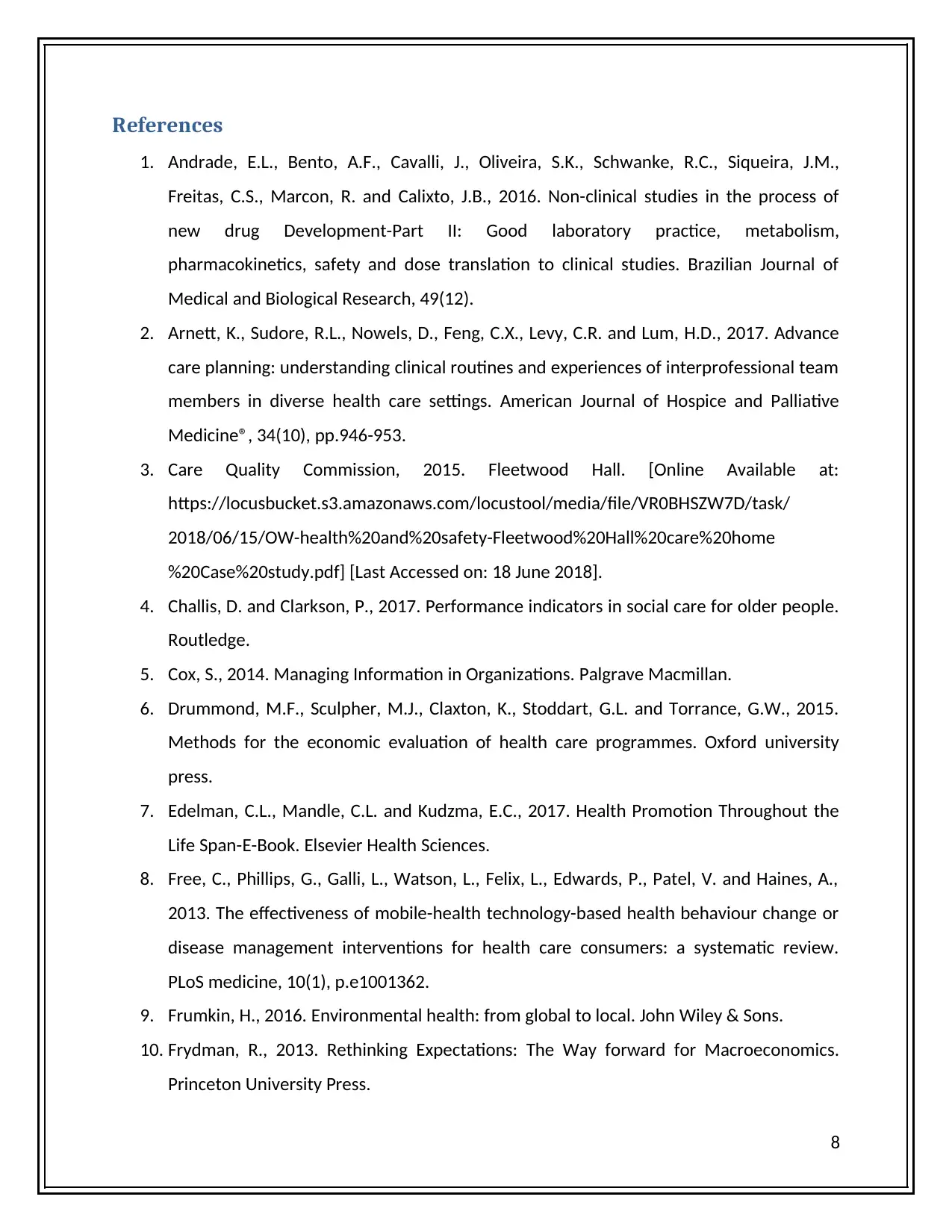
References
1. Andrade, E.L., Bento, A.F., Cavalli, J., Oliveira, S.K., Schwanke, R.C., Siqueira, J.M.,
Freitas, C.S., Marcon, R. and Calixto, J.B., 2016. Non-clinical studies in the process of
new drug Development-Part II: Good laboratory practice, metabolism,
pharmacokinetics, safety and dose translation to clinical studies. Brazilian Journal of
Medical and Biological Research, 49(12).
2. Arnett, K., Sudore, R.L., Nowels, D., Feng, C.X., Levy, C.R. and Lum, H.D., 2017. Advance
care planning: understanding clinical routines and experiences of interprofessional team
members in diverse health care settings. American Journal of Hospice and Palliative
Medicine®, 34(10), pp.946-953.
3. Care Quality Commission, 2015. Fleetwood Hall. [Online Available at:
https://locusbucket.s3.amazonaws.com/locustool/media/file/VR0BHSZW7D/task/
2018/06/15/OW-health%20and%20safety-Fleetwood%20Hall%20care%20home
%20Case%20study.pdf] [Last Accessed on: 18 June 2018].
4. Challis, D. and Clarkson, P., 2017. Performance indicators in social care for older people.
Routledge.
5. Cox, S., 2014. Managing Information in Organizations. Palgrave Macmillan.
6. Drummond, M.F., Sculpher, M.J., Claxton, K., Stoddart, G.L. and Torrance, G.W., 2015.
Methods for the economic evaluation of health care programmes. Oxford university
press.
7. Edelman, C.L., Mandle, C.L. and Kudzma, E.C., 2017. Health Promotion Throughout the
Life Span-E-Book. Elsevier Health Sciences.
8. Free, C., Phillips, G., Galli, L., Watson, L., Felix, L., Edwards, P., Patel, V. and Haines, A.,
2013. The effectiveness of mobile-health technology-based health behaviour change or
disease management interventions for health care consumers: a systematic review.
PLoS medicine, 10(1), p.e1001362.
9. Frumkin, H., 2016. Environmental health: from global to local. John Wiley & Sons.
10. Frydman, R., 2013. Rethinking Expectations: The Way forward for Macroeconomics.
Princeton University Press.
8
1. Andrade, E.L., Bento, A.F., Cavalli, J., Oliveira, S.K., Schwanke, R.C., Siqueira, J.M.,
Freitas, C.S., Marcon, R. and Calixto, J.B., 2016. Non-clinical studies in the process of
new drug Development-Part II: Good laboratory practice, metabolism,
pharmacokinetics, safety and dose translation to clinical studies. Brazilian Journal of
Medical and Biological Research, 49(12).
2. Arnett, K., Sudore, R.L., Nowels, D., Feng, C.X., Levy, C.R. and Lum, H.D., 2017. Advance
care planning: understanding clinical routines and experiences of interprofessional team
members in diverse health care settings. American Journal of Hospice and Palliative
Medicine®, 34(10), pp.946-953.
3. Care Quality Commission, 2015. Fleetwood Hall. [Online Available at:
https://locusbucket.s3.amazonaws.com/locustool/media/file/VR0BHSZW7D/task/
2018/06/15/OW-health%20and%20safety-Fleetwood%20Hall%20care%20home
%20Case%20study.pdf] [Last Accessed on: 18 June 2018].
4. Challis, D. and Clarkson, P., 2017. Performance indicators in social care for older people.
Routledge.
5. Cox, S., 2014. Managing Information in Organizations. Palgrave Macmillan.
6. Drummond, M.F., Sculpher, M.J., Claxton, K., Stoddart, G.L. and Torrance, G.W., 2015.
Methods for the economic evaluation of health care programmes. Oxford university
press.
7. Edelman, C.L., Mandle, C.L. and Kudzma, E.C., 2017. Health Promotion Throughout the
Life Span-E-Book. Elsevier Health Sciences.
8. Free, C., Phillips, G., Galli, L., Watson, L., Felix, L., Edwards, P., Patel, V. and Haines, A.,
2013. The effectiveness of mobile-health technology-based health behaviour change or
disease management interventions for health care consumers: a systematic review.
PLoS medicine, 10(1), p.e1001362.
9. Frumkin, H., 2016. Environmental health: from global to local. John Wiley & Sons.
10. Frydman, R., 2013. Rethinking Expectations: The Way forward for Macroeconomics.
Princeton University Press.
8
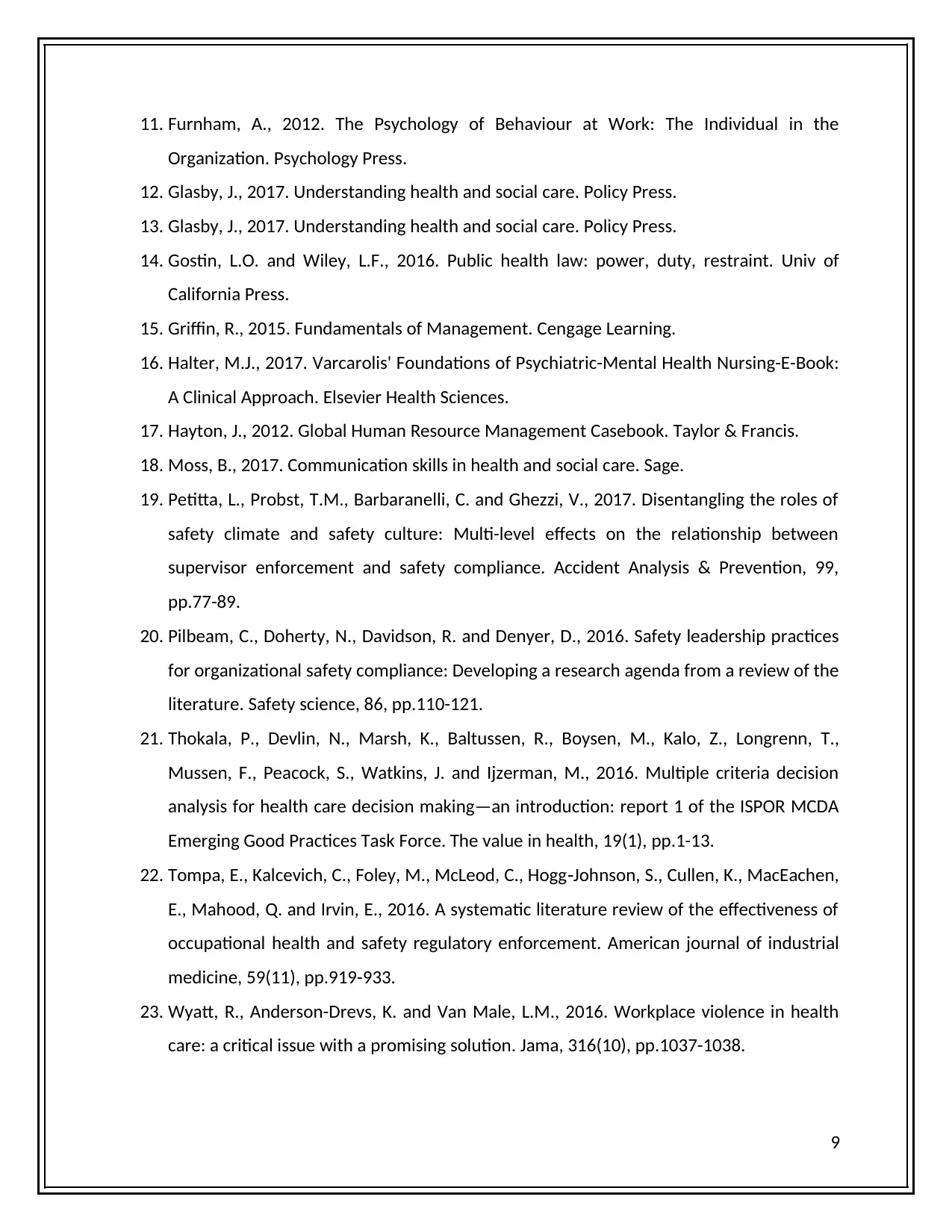
11. Furnham, A., 2012. The Psychology of Behaviour at Work: The Individual in the
Organization. Psychology Press.
12. Glasby, J., 2017. Understanding health and social care. Policy Press.
13. Glasby, J., 2017. Understanding health and social care. Policy Press.
14. Gostin, L.O. and Wiley, L.F., 2016. Public health law: power, duty, restraint. Univ of
California Press.
15. Griffin, R., 2015. Fundamentals of Management. Cengage Learning.
16. Halter, M.J., 2017. Varcarolis' Foundations of Psychiatric-Mental Health Nursing-E-Book:
A Clinical Approach. Elsevier Health Sciences.
17. Hayton, J., 2012. Global Human Resource Management Casebook. Taylor & Francis.
18. Moss, B., 2017. Communication skills in health and social care. Sage.
19. Petitta, L., Probst, T.M., Barbaranelli, C. and Ghezzi, V., 2017. Disentangling the roles of
safety climate and safety culture: Multi-level effects on the relationship between
supervisor enforcement and safety compliance. Accident Analysis & Prevention, 99,
pp.77-89.
20. Pilbeam, C., Doherty, N., Davidson, R. and Denyer, D., 2016. Safety leadership practices
for organizational safety compliance: Developing a research agenda from a review of the
literature. Safety science, 86, pp.110-121.
21. Thokala, P., Devlin, N., Marsh, K., Baltussen, R., Boysen, M., Kalo, Z., Longrenn, T.,
Mussen, F., Peacock, S., Watkins, J. and Ijzerman, M., 2016. Multiple criteria decision
analysis for health care decision making—an introduction: report 1 of the ISPOR MCDA
Emerging Good Practices Task Force. The value in health, 19(1), pp.1-13.
22. Tompa, E., Kalcevich, C., Foley, M., McLeod, C., Hogg Johnson, S., Cullen, K., MacEachen,‐
E., Mahood, Q. and Irvin, E., 2016. A systematic literature review of the effectiveness of
occupational health and safety regulatory enforcement. American journal of industrial
medicine, 59(11), pp.919-933.
23. Wyatt, R., Anderson-Drevs, K. and Van Male, L.M., 2016. Workplace violence in health
care: a critical issue with a promising solution. Jama, 316(10), pp.1037-1038.
9
Organization. Psychology Press.
12. Glasby, J., 2017. Understanding health and social care. Policy Press.
13. Glasby, J., 2017. Understanding health and social care. Policy Press.
14. Gostin, L.O. and Wiley, L.F., 2016. Public health law: power, duty, restraint. Univ of
California Press.
15. Griffin, R., 2015. Fundamentals of Management. Cengage Learning.
16. Halter, M.J., 2017. Varcarolis' Foundations of Psychiatric-Mental Health Nursing-E-Book:
A Clinical Approach. Elsevier Health Sciences.
17. Hayton, J., 2012. Global Human Resource Management Casebook. Taylor & Francis.
18. Moss, B., 2017. Communication skills in health and social care. Sage.
19. Petitta, L., Probst, T.M., Barbaranelli, C. and Ghezzi, V., 2017. Disentangling the roles of
safety climate and safety culture: Multi-level effects on the relationship between
supervisor enforcement and safety compliance. Accident Analysis & Prevention, 99,
pp.77-89.
20. Pilbeam, C., Doherty, N., Davidson, R. and Denyer, D., 2016. Safety leadership practices
for organizational safety compliance: Developing a research agenda from a review of the
literature. Safety science, 86, pp.110-121.
21. Thokala, P., Devlin, N., Marsh, K., Baltussen, R., Boysen, M., Kalo, Z., Longrenn, T.,
Mussen, F., Peacock, S., Watkins, J. and Ijzerman, M., 2016. Multiple criteria decision
analysis for health care decision making—an introduction: report 1 of the ISPOR MCDA
Emerging Good Practices Task Force. The value in health, 19(1), pp.1-13.
22. Tompa, E., Kalcevich, C., Foley, M., McLeod, C., Hogg Johnson, S., Cullen, K., MacEachen,‐
E., Mahood, Q. and Irvin, E., 2016. A systematic literature review of the effectiveness of
occupational health and safety regulatory enforcement. American journal of industrial
medicine, 59(11), pp.919-933.
23. Wyatt, R., Anderson-Drevs, K. and Van Male, L.M., 2016. Workplace violence in health
care: a critical issue with a promising solution. Jama, 316(10), pp.1037-1038.
9
1 out of 24
Related Documents
Your All-in-One AI-Powered Toolkit for Academic Success.
+13062052269
info@desklib.com
Available 24*7 on WhatsApp / Email
![[object Object]](/_next/static/media/star-bottom.7253800d.svg)
Unlock your academic potential
© 2024 | Zucol Services PVT LTD | All rights reserved.





